آفريڪا ۾ عالمي ورثي جي ماڳن جي فهرست

0 سائيٽون
1-2 سائيٽون
3-4 سائيٽون
5-6 سائيٽون
7-8 سائيٽون
9 سائيٽون
گڏيل قومن جي تعليمي، سائنسي ۽ ثقافتي تنظيم، يونيسڪو آفريڪا ۾ 147 عالمي ورثو ماڳن کي نامزد ڪيو آهي. هي ماڳ 46 ملڪن ۾ پکڙيل آهن.
عالمي ورثي ماڳن جي چونڊ
[سنواريو][[ايٿوپيا کي يارهن ماڳن سان برتري حاصل آهي. ان کان پوءِ ڏکڻ آفريڪا ڏهه، مراڪش ۽ تيونس ۾ نون ماڳن جو گهر آهي. پوءِ الجزائر، مصر، سينيگال ۽ تنزانيا ست نمبر تي آهن. نون ملڪن ۾ صرف ھڪڙي ھڪڙي سائيٽ آھي. ٻن ملڪن جي وچ ۾ چار سائيٽون ورهايل آهن: مالوٽي-ڊراڪنسبرگ پارڪ (ليسوٿو ۽ ڏکڻ آفريڪا)، جبل نيمبا سخت فطري ريزرو (ڪوٽ ڊي آئيور ۽ گني)، سينيگامبيا جا پٿر جا حلقا (گيمبيا ۽ سينيگال) ۽ موسي-اوا-تونيا/ وڪٽوريا آبشار (زمبيا ۽ زمبابوي) جي وچ ۾ ورهايل آهن. ٻه سائيٽون ٽن ملڪن ۾ ورهايل آهن: سانگها ٽرائي نيشنل (وچ آفريڪا، ڪيمرون ۽ ڪانگو) ۽ ڊبليو-آرلي-پينجاري ڪمپليڪس (بينن، برڪينا فاسو ۽ نائيجر جي وچ ۾ ورهايل آهي. کنڊ کان پهرين سائيٽون 1978ع ۾ لکيا ويا، جڏهن سينيگال جي گوري ٻيٽ ۽ ايٿوپيا جي راڪ-هيون گرجا گھر ۽ سيمين نيشنل پارڪ کي فهرست جي تصور دوران چونڊيو ويو. سيپٽمبر، 2017ع تائين، صوماليا وٽ ڪوبه سرڪاري عالمي ورثو سائيٽون نه آهن ڇو ته صومالي حڪومت سال 1972ع جي عالمي ورثي واري ڪنوينشن جي پارٽي نه آهي. بهرحال، اتي گهٽ ۾ گهٽ، هڪ درجن جي لڳ ڀڳ ملڪن ۾ آثار قديمه جي ماڳن جو يقين آهي ته مستقبل جي امڪاني اميدوارن جي عالمي ورثي جي حيثيت لاء، آهي. هر سال، يونيسڪو جي عالمي ورثي واري ڪميٽي نئين سائيٽن کي لسٽ ۾ شامل ڪري سگهي ٿي يا انهن سائيٽن کي خارج ڪري سگھي ٿو جيڪي هاڻي معيار کي پورا نه ڪن. چونڊ ڏهن معيارن تي ٻڌل آهي:
- ثقافتي ورثي لاءِ ڇهه (i-vi) ۽
- چار قدرتي ورثي لاءِ (vii-x)
ڪجهه سائيٽون، نامزد ٿيل "مخلوط سائيٽون"، ٻنهي ثقافتي ۽ قدرتي ورثي جي نمائندگي ڪن ٿيون. آفريڪا ۾، 91 ثقافتي، 50 قدرتي ۽ 6 مخلوط سائيٽون آھن. سائيٽن جو تعداد وڌائڻ ۽ براعظم تي موجود ماڳن جي ورثي کي بچائڻ لاءِ ڪيتريون ئي ڪوششون وقف ڪيون ويون آھن.
عالمي ورثي جا ماڳ
[سنواريو]ليجنڊ
[سنواريو]هيٺ ڏنل فهرست يونيسڪو جي آفريڪا جي جيو پوليٽيڪل تعريف کي نظر انداز ڪري ٿي ۽ ان ۾ اها شامل آهن، جنهن کي يونيسڪو "عرب رياستن" ۾ ماڳن جي طور تي بيان ڪري ٿي.[1] مصر اتر آفريڪا جو حصو آهي. فهرست ۾ ڪيترائي ماڳ پڻ شامل آھن جن لاءِ رياستي پارٽي کنڊ کان ٻاھر آھي، پر ماڳ پاڻ آفريڪا ۾ واقع آھي؛ چار اهڙيون ماڳون ڪينري ٻيٽن تي واقع آهن (جن جو تعلق اسپين سان آهي)، هڪ ميڊيرا (پرتگال سان تعلق رکندڙ) تي، هڪ ري يونين (فرانس سان تعلق رکندڙ) ۽ هڪ ٽرسٽان دا ڪنها ٻيٽ تي (برطانيا سان تعلق رکي ٿو) آهي.
ٽيبل مناسب ڪالمن جي چوٽي تي ڪلڪ ڪري ڪالمن جي ترتيب سان ترتيب ڏنل آهي. اکر-انگ طور ماڳ، ايراضي ۽ سال ڪالمن لاءِ؛ رياستي پارٽي طرفان بعد ۾ علائقي جي جڳهه ڪالمن لاءِ؛ ۽ معيار جي قسم جي پٺيان ملڪ طرفان معيار جي ڪالمن لاءِ.
نثري ٽڪرو وجھو
- ماڳ: ورلڊ هيريٽيج ڪميٽي جي سرڪاري نامزدگي جي نالي پٺيان رکيو ويو. n[2]
- جڳھه: ملڪ طرفان ترتيب ڏنل، علائقائي يا صوبائي سطح تي علائقي جي پٺيان. ملٽي نيشنل يا ملٽي ريجنل ماڳ جي صورت ۾، نالا ترتيب ڏنل الفابيٽ سان.
- معيار: جيئن بيان ڪيل عالمي ورثو ڪميٽي پاران.
- ايراضي: هيڪٽرن ۽ ايڪڙن ۾، ڪنهن به بفر زونن کان سواء. هڪ قدر جو "-" مطلب آهي ته يونيسڪو طرفان ڪا به ڊيٽا شايع نه ڪئي وئي آهي.
- سال: جنهن دوران ماڳ عالمي ورثي جي لسٽ ۾ شامل ڪيو ويو.
- وضاحت: ماڳ بابت مختصر معلومات، بشمول ورثي واري ماڳ جي طور تي قابليت جا سبب.
ماڳ
[سنواريو]| ماڳ | تصوير | جاء | معيار | ايراضي
هيڪٽر (ايڪڙ ۾) |
سال | وضاحت |
|---|---|---|---|---|---|---|
| آپراواسي گھاٽ |  |
پورٽ لوئيس ضلعو 20°09′31″S 57°30′11″E / 20.158611°S 57.503056°E |
ڪلچرل: (iv) | 0.16 (0.40) | 2006 | انگريزن پاران ماريشس ۾ غلاميءَ جي خاتمي کان پوءِ، برطانوي حڪومت طرفان آپراواسي گھاٽ کي چونڊيو ويو ته جيئن هندستاني مزدورن کي ملڪ ۾ فارمن ۽ کنڊ جي زمينن تي ڪم ڪرڻ لاءِ موڪليو وڃي. سال 1834ع ۽ 1920ع جي وچ ۾ اٽڪل پنج لک کنٽريڪٽ ٿيل مزدور انڊيا مان پورٽ لوئس مان لنگهيا، يا ته ماريشس ۾ ڪم ڪرڻ لاءِ يا ٻين برطانوي نوآبادين ڏانهن منتقل ٿيڻ لاءِ.[3] |
| ابو مينا † |  |
ابوسر، 30°50′28″N 29°39′47″E / 30.84098°N 29.663117°E |
ثقافتي: (iv) | 182 (450) | 1979 | اڳوڻي عيسائي مقدس شهر جي کنڊرن ۾ هڪ چرچ، هڪ بپتسما جي جاء، بيسيليڪا، عوامي عمارتون، گهٽيون، خانقاهون، گهر ۽ ورڪشاپون شامل آهن ۽ اليگزينڊرريا جي ميناس جي مقبري مٿان ٺهيل هئا.[4] عالمي ورثي واري ڪميٽي ابو مينا کي 2001ع ۾، ان علائقي ۾ ٻين غارن جي ٺھڻ، علائقي جي سطح تي مٽي جيڪا "وڌيڪ پاڻي" سان ملڻ تي نيم مائع ٿي وڃي ٿي.[5] |
| ايير ۽ تئنئري قدرتي محفوظ علائقو |  |
آرلٽ ڊپارٽمينٽ 18°N 9°E / 18°N 9°E |
قدرتي:
vii، ix x |
7٬736٬000 (19٬120٬000) | 1991 | آفريڪا جو سڀ کان وڏو محفوظ علائقو، جيڪو صحارا ريگستان ۾ تينيري ۾ واقع آهي، ايير جي آتش فشاني پٿر جي ماس تي مشتمل آهي ۽ منفرد نباتات ۽ جانورن سان گڏ هڪ ننڍڙو الڳ ٿيل ساحيلي خطو آهي.[6] قدرتي رزرو کي سال 1992ع ۾، فوجي تڪرار ۾ اضافي ۽ فيبروري ۾ ڇهه ريزرو عملي جي يرغمال ٿيڻ سبب، يونيسڪو جي عالمي ورثي جي خطري واري فهرست ۾ شامل ڪيو ويو. هن فهرست مان هٽائڻ تي غور ڪيو ويو 1999ع ۾، پر 2011ع تائين، ان جي پوزيشن ۾ ڪا تبديلي نه رهي.[7][8] |
| اڪسوم |  |
ٽگري ريجن 14°07′49″N 38°43′07″E / 14.130190°N 38.718605°E |
ثقافتي:
|
- | 1980 | اڪسوم شهر جا کنڊر، پهرين کان 13هين صدي عيسويءَ تائين، قديم ايٿوپيائي تهذيب جي مرڪز جي نشاندهي ڪن ٿا. ان ۾ مونو ليٿڪ اوبليسڪ، وڏي اسٽيلائي، شاهي مقبرا ۽ اڳوڻي قلعن جا کنڊر شامل آهن.[9] |
| قلعات بني حماد |  |
مادد، 35°49′06″N 4°47′13″E / 35.818440°N 4.786840°E |
ثقافتي: (iii) |
150 (370) | 1980 | The fortified first capital of the HammadiH Emirs built in 1007 and demolished in 1152. It features an 8-bay, 13-aisle mosque, which is one of the largest in Algeria.[10] |
| الدبرا اتول |  |
الدبرا گروپ، 9°25′00″S 46°25′00″E / 9.416681°S 46.41665°E |
فطري:
|
35٬000 (86٬000)
|
1982 | The Aldabra Atoll consists of four large coral islands and a lagoon, surrounded by a coral reef. The islands are home to the world's largest population of giant tortoises.[11] |
| ال جيم جو ايمڦي ٿيٽر |  |
ايل جيم، 35°17′47″N 10°42′25″E / 35.296390°N 10.706940°E |
ثقافتي:
|
1.37 (3.4) | 1979 | The Amphitheatre of El Jem, built during the 3rd century, is North Africa's largest amphitheatre, and the largest one built outside of Italy, with a capacity of 35,000 spectators, and "illustrates the grandeur and extent of Imperial Rome".[12] |
2
[سنواريو]|-
! scope="row" | Ancient Ferrous Metallurgy Sites of Burkina Faso
| align=center | || align="center" | Douroula,
Tiwêga,
Yamané,
Kindibo,
Békuy,![]() برڪينا فاسو
برڪينا فاسو
12°35′16″N 3°19′44″W / 12.5877583°N 3.3289861°W || Cultural:
(iii), (iv), (vi) || align="center" | 122.3 (302) || align="center" | 2019 || A series of five archaeological locations spread across the country, recognized for their historical significance in the development and practice of iron smelting technology in Africa. Each site contains remains of furnaces and other features associated with the iron production process, showcasing the technological innovation and skill of the people in this region. [13]
|-
! scope="row" | Ancient Ksour of Ouadane, Chinguetti, Tichitt and Oualata
| align=center |

|| align="center" | Chinguetti,
Ouadane,
Oualata,
and Tichitt,![]() موريتانيا
موريتانيا
20°55′44″N 11°37′25″W / 20.928890°N 11.623610°W || Cultural:
(iii), (iv), (v) || align="center" | — || align="center" | 1996 || "Founded in the 11th and 12th centuries to serve the caravans crossing the Sahara, these trading and religious centres became focal points of Islamic culture. [...] Typically, houses with patios crowd along narrow streets around a mosque with a square minaret. They illustrate a traditional way of life centred on the nomadic culture of the people of the western Sahara."[14]
|- ! scope="row" | Ancient Thebes with its Necropolis
|

|| align="center" | Luxor,![]() مصر
مصر
25°44′00″N 32°36′00″E / 25.733330°N 32.600000°E || Cultural:
(i), (iii), (vi) || align="center" | 7٬390 (18٬300) || align="center" | 1979 || The former capital of Egypt and city of the Egyptian god Amun contains relics from the height of Ancient Egypt. The temples, palaces, and the necropolises of the Valley of the Kings and the Valley of the Queens bear "a striking testimony to Egyptian civilization".[15]
|- ! scope="row" | Archaeological Site of Carthage
|
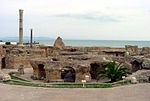
|| align="center" | Tunis,![]() تيونس
تيونس
36°51′10″N 10°19′24″E / 36.852780°N 10.323330°E || Cultural:
(ii), (iii), (vi) || align="center" | 498 (1٬230) || align="center" | 1979 || Founded in the 9th century BCE, Carthage was developed into a trading empire spanning the Mediterranean and was, according to UNESCO, "home to a brilliant civilization". The city was destroyed in 146 BCE in the Punic Wars at the hands of the Romans, but was later rebuilt by these.[16]
|- style="background:#FFE6BD" ! scope="row" | Archaeological Site of Cyreneسانچو:†
|

|| align="center" | Jebel Akhdar,![]() لبيا
لبيا
32°49′30″N 21°51′30″E / 32.825000°N 21.858330°E || Cultural:
(ii), (iii), (vi) || align="center" | 132 (330) || align="center" | 1982 || The formerly Greek colony was Romanized and transformed into a capital, until it was destroyed by the 365 Crete earthquake. The thousand-year-old ruins have remained renowned since the 18th century.[17] All five sites in Libya, including Cyrene, were placed on UNESCO's List of World Heritage in Danger in 2016, due to ongoing conflict in the country.[18]
|- style="background:#FFE6BD" ! scope="row" | Archaeological Site of Leptis Magnaسانچو:†
| align=center |

|| align="center" | Khoms,![]() لبيا
لبيا
32°38′18″N 14°17′35″E / 32.638330°N 14.293060°E || Cultural:
(i), (ii), (iii) || align="center" | 387 (960) || align="center" | 1982 || The Roman city of Leptis Magna was enlarged by Emperor Septimius Severus, who was born there. Public monuments, a harbour, a marketplace, storehouses, shops, and homes were among the reasons for its induction into the list.[19] All five sites in Libya, including Leptis Magna, were placed on UNESCO's List of World Heritage in Danger in 2016, due to ongoing conflict in the country.[20]
|- style="background:#FFE6BD" ! scope="row" | Archaeological Site of Sabrathaسانچو:†
|

|| align="center" | Sabratha,![]() لبيا
لبيا
32°48′19″N 12°29′06″E / 32.805280°N 12.485000°E || Cultural:
(iii) || align="center" | 91 (220) || align="center" | 1982 || "A Phoenician trading-post that served as an outlet for the products of the African hinterland, Sabratha was part of the short-lived Numidian Kingdom of Massinissa before being Romanized and rebuilt in the 2nd and 3rd centuries."[21] All five sites in Libya, including Sabratha, were placed on UNESCO's List of World Heritage in Danger in 2016, due to ongoing conflict in the country.[22]
|- ! scope="row" | Archaeological Site of Volubilis
|

|| align="center" | Meknes,![]() مراڪش
مراڪش
34°04′26″N 5°33′25″W / 34.073890°N 5.556940°W || Cultural:
(ii), (iii), (iv), (vi) || align="center" | 42 (100) || align="center" | 1997 || The important Roman outpost of Volubilis was founded in the 3rd century BCE to become the capital of Mauretania. It contained many buildings, the remains of which have survived extensively to this day.[23]
|- ! scope="row" | Archaeological Sites of the Island of Meroe
|

|| align="center" | Meroë,![]() سوڊان
سوڊان
16°56′00″N 33°43′00″E / 16.933333°N 33.716667°E || Cultural:
(ii), (iii), (iv), (v) || align="center" | 2٬357 (5٬820) || align="center" | 2011 || The site was the centre of the Kingdom of Kush, a major force active from the 8th century BCE to the 4th century CE. It is home to pyramids, temples, and domestic buildings, among other vestiges.[24]
|-
! scope="row" | Asante Traditional Buildings
| align="center" | || align="center" | Kumasi,![]() گهانا
گهانا
6°24′04″N 1°37′33″W / 6.401111°N 1.625833°W || Cultural:
(v) || align="center" | — || align="center" | 1980 || The site, north-east of Kumasi, hosts the final intact remains of the Ashanti Empire, which peaked in the 18th century. The dwellings, which are made of earth, wood, and straw, are susceptible to the damages caused by the "onslaught of time and weather".[25]
|-
! scope="row" | Asmara: A Modernist African City[lower-alpha 1]
| align="center" |

|| align="center" | Maekel,![]() اريٽيريا
اريٽيريا
15°20′07″N 38°56′09″E / 15.335277777777778°N 38.935833333333335°E || Cultural:
(ii)(iv) || align="center" | 481 (1٬190) || align="center" | 2017 || Located at over 2000 metres above sea level, the capital of Eritrea developed from the 1890s onwards as a military outpost for the Italian colonial power. After 1935, Asmara underwent a large scale programme of construction applying the Italian rationalist idiom of the time to governmental edifices, residential and commercial buildings, churches, mosques, synagogues, cinemas, hotels, etc.[26]
|- ! scope="row" | Barberton Makhonjwa Mountains
|

|| align="center" | Mpumalanga,![]() ڏکڻ آفريقا
ڏکڻ آفريقا
25°58′26″S 31°00′50″E / 25.973889°S 31.013889°E || Natural:
(viii) || align="center" | 113٬137 (279٬570) || align="center" | 2018 || The mountains contain the world's oldest geological structures and are known to have preserved volcanic and sedimentary rocks estimated to be between 3.6 and 3.25 billion years old.[27]
|- ! scope="row" | Banc d'Arguin National Park
|

|| align="center" | Azefal
and Nouadhibou,![]() موريتانيا
موريتانيا
20°14′05″N 16°06′32″W / 20.234720°N 16.108890°W || Natural:
(ix), (x) || align="center" | 1٬200٬000 (3٬000٬000) || align="center" | 1989 || The park consists of sand dunes, coastal swamps, small islands, and shallow bodies of water, all bordering the coast of the Atlantic Ocean. Birds are often found to migrate in the area, accompanied by various species of sea turtles and dolphins, whose presence fishermen often use to attract fish.[28]
|- ! scope="row" | Bassari Country: Bassari, Fula and Bedik Cultural Landscapes
|
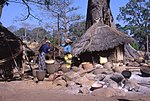
|| align="center" | ![]() سينيگال
سينيگال
12°35′36″N 12°50′45″W / 12.593333°N 12.845833°W || Cultural:
(iii), (v), (vi) || align="center" | 50٬309 (124٬320) || align="center" | 2012 || This area stands out for its cultural diversity and the preservation of traditional lifestyles, deeply intertwined with the natural environment. The communities maintain unique cultural identities, practices, and structures, reflecting their adaptation to the landscape. Their traditional practices, including agriculture, architecture, and religious ceremonies.[29]
|- ! scope="row" | Bwindi Impenetrable National Park
|
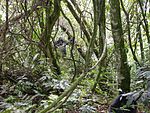
|| align="center" | Kabale District,
Kisoro District,
and Rukungiri District,![]() يوگينڊا
يوگينڊا
1°04′50″S 29°39′41″E / 1.080556°S 29.661389°E || Natural:
(vii), (x) || align="center" | 32٬092 (79٬300) || align="center" | 1994 || Located on the border of plains and mountain forests, the park in south-western Uganda is home to over 160 species of trees, over a hundred species of ferns, and various species of birds and butterflies. Many endangered species are within its boundaries as well, including the mountain gorilla.[30]
|- ! scope="row" | Cape Floral Region Protected Areas
|
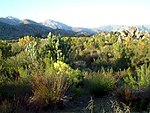
|| align="center" | Eastern Cape
and Western Cape,![]() ڏکڻ آفريقا
ڏکڻ آفريقا
34°21′40″S 18°28′30″E / 34.361111°S 18.475000°E || Natural:
(ix), (x) || align="center" | 1٬094٬742 (2٬705٬170) || align="center" | 2004[lower-alpha 2] || The site consists of eight protected areas that are among the richest in plant life worldwide, containing nearly 20% of Africa's total flora. Its scientific value is demonstrated by the presence of fire and radiation adaptivity in plants and seed dispersal by insects.[31]
|- ! scope="row" | Chongoni Rock-Art Area
|

|| align="center" | Dedza District,![]() ملاوي
ملاوي
14°17′36″S 34°16′45″E / 14.293333°S 34.279167°E || Cultural:
(iii), (vi) || align="center" | 12٬640 (31٬200) || align="center" | 2006 || The 127-site area contains the richest concentration of rock art in Central Africa, ranging from Stone Age paintings to contemporary work from farmers. The symbols depicted in the rock art are strongly centred around women and retain a cultural significance for the Chewa.[32]
|- ! scope="row" | Cidade Velha, Historic Centre of Ribeira Grande
| align=center |

|| align="center" | Ribeira Grande,![]() ڪيپ ورڊي
ڪيپ ورڊي
14°54′55″N 23°36′19″W / 14.915139°N 23.605194°W || Cultural:
(ii), (iii), (vi) || align="center" | 209 (520) || align="center" | 2009 || The town, in the south of the island of Santiago, was the first European colonial outpost in the tropics, with remains dating back to the 16th century. Two churches, a royal fortress, and Pillary Square help comprise the tropical town's original street layout.[33]
|- ! scope="row" | Cliff of Bandiagara (Land of the Dogons)
|

|| align="center" | Bandiagara Cercle,![]() مالي
مالي
14°20′00″N 3°25′00″W / 14.333330°N 3.416670°W || Mixed:
(v), (vii) || align="center" | 327٬390 (809٬000) || align="center" | 1989 || The sandy plateau and cliffs of Bandiagara outline the site, featuring houses, granaries, altars, sanctuaries, and Togu-Na meeting-places. Age-old social traditions such as masks, feasts, rituals, and ancestral worship also add to its cultural significance.[34]
|- ! scope="row" | Comoé National Park
| align="center" |

|| align="center" | Zanzan,![]() آئيوري ڪوسٽ
آئيوري ڪوسٽ
9°N 4°W / 9°N 4°W || Natural:
(ix), (x) || align="center" | 1٬150٬000 (2٬800٬000) || align="center" | 1983 || Among the largest protected sites of West Africa, the park features the Comoé River and the unique flora which accompanies it.[35] The site was placed on UNESCO's List of World Heritage in Danger in 2003, due to unrest in Côte d'Ivoire, and various other factors such as poaching, wildfires, lack of proper management of the site, and overgrazing.[36] It was later removed from the list in 2017 following successful efforts to fight poaching, leading to increases in populations of fauna such as elephants and chimpanzees.[37]
|- ! scope="row" | Dja Faunal Reserve
|

|| align="center" | Dja-et-Lobo
and Haut-Nyong,![]() ڪيمرون
ڪيمرون
3°N 13°E / 3°N 13°E || Natural:
(ix), (x) || align="center" | 526٬000 (1٬300٬000) || align="center" | 1987 || Among Africa's largest and best-protected rain forests, the Cameroonian reserve is almost completely surrounded by the Dja River and contains 107 mammal species, of which five are threatened.[38]
|-
! scope="row" | Djémila
|  || align="center" | Sétif,
|| align="center" | Sétif,![]() الجزائر
الجزائر
36°19′14″N 5°44′12″E / 36.320560°N 5.736670°E || Cultural:
(iii), (iv) || align="center" | 30 (74) || align="center" | 1982 || The ruins of a Roman town in a mountainous location, including a forum, temples, basilicas, triumphal arches, and houses, each adapted to a location 900 m (3٬000 ft) above sea level.[39]
|-
! scope="row" | Djoudj National Bird Sanctuary
|

|| align="center" | Saint-Louis Region,![]() سينيگال
سينيگال
16°30′00″N 16°10′00″W / 16.500000°N 16.166670°W || Natural:
(vii), (x) || align="center" | 16٬000 (40٬000) || align="center" | 1981 || The Senegal River delta wetland area consists of streams, lakes, ponds, and backwaters. It is the home to 1.5 million birds, including the great white pelican, the purple heron, the African spoonbill, the great egret, and cormorants. The sanctuary also features crocodiles, African manatees, and other typical Sahelian species.[40] The site was previously on the danger list from 1984 to 1988 due to potential impact from a dam[41][42] and again from 2000 to 2006 due to invasive species.[43][44]
|- ! scope="row" | Dougga / Thugga
|

|| align="center" | Béja Governorate,![]() تيونس
تيونس
36°25′25″N 9°13′13″E / 36.423610°N 9.220280°E || Cultural:
(ii), (iii) || align="center" | 75 (190) || align="center" | 1997 || The site features the ruins of Dougga, a former capital of a Libyan–Punic state, which flourished under Ancient Rome and the Byzantine Empire, but declined in the Islamic period.[45]
|- ! scope="row" | Ecosystem and Relict Cultural Landscape of Lopé-Okanda
|

|| align="center" | Ogooué-Ivindo
and Ogooué-Lolo,![]() گيبون
گيبون
0°30′N 11°30′E / 0.5°N 11.5°E || Mixed:
(iii), (iv),
(ix), (x) || align="center" | 491٬291 (1٬214٬010) || align="center" | 2007 || The park features well-preserved tropical rain forests and savanna, resulting in a diverse ecosystem consisting of endangered, large mammals.[46]
|-
! scope="row" | Ennedi Massif: Natural and Cultural Landscape
|  || align="center" |
|| align="center" | ![]() چاڊ
چاڊ
17°02′30″N 21°51′46″E / 17.04167°N 21.86278°E || Mixed:
(iii), (vii), (ix) || align="center" | 2٬441٬200 (6٬032٬000) || align="center" | 2016 || [47]
|-
! scope="row" | Fasil Ghebbi, Gondar Region
|

|| align="center" | Amhara Region,![]() ايٿوپيا
ايٿوپيا
12°36′25″N 37°27′58″E / 12.606920°N 37.466170°E || Cultural:
(ii), (iii) || align="center" | — || align="center" | 1979 || The fortress was the residence of the Ethiopian emperors during the 16th and 17th century. The city remains, which feature buildings with Hindu and Arab influences, were later remodelled with Baroque-style architecture by Jesuit missionaries.[48]
|- ! scope="row" | Fort Jesus, Mombasa
|

|| align="center" | Mombasa,![]() ڪينيا
ڪينيا
4°03′46″S 39°40′46″E / 4.062778°S 39.679444°E || Cultural:
(ii), (iv) || align="center" | 2.36 (5.8) || align="center" | 2011 || Fort Jesus is a Portuguese fort built from 1593 to 1596 on Mombasa Island to guard the old port of Mombasa, Kenya. The site's layout follows the Renaissance ideal that the human body is perfectly proportionate.[49]
|- ! scope="row" | Forts and Castles, Volta, Greater Accra, Central and Western Regions
|
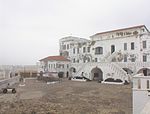
|| align="center" | Central Region,
Greater Accra,
Volta Region,
and Western Region,![]() گهانا
گهانا
5°14′51″N 0°47′07″W / 5.247398°N 0.785167°W || Cultural:
(vi) || align="center" | — || align="center" | 1979 || The site features the remains of fortified trading posts, built along the Ghanaian coast between 1482 and 1786.[50]
|- ! scope="row" | Fossil Hominid Sites of South Africa
|

|| align="center" | Gauteng,
Limpopo,
and North West,![]() ڏکڻ آفريقا
ڏکڻ آفريقا
24°09′31″S 29°10′37″E / 24.158610°S 29.176940°E || Cultural:
(iii), (vi) || align="center" | — || align="center" | 1999[lower-alpha 3] || The various fossil sites contain traces of human occupation and evolution dating 3.3 million years.[51]
|- ! scope="row" | French Austral Lands and Seas
| align=center |

|| align="center" | Crozet Islands,
Kerguelen Islands,
Île Saint-Paul,
Île Amsterdam![]() فرانس
فرانس
49°22′49″S 69°21′10″E / 49.3803611°S 69.3528056°E || Natural:
(vii), (ix), (x) || align="center" | 67٬296٬900 (166٬294٬000) || align="center" | 2019 || [52]
|- ! scope="row" | Garajonay National Park
|
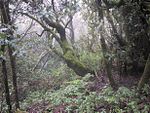
|| align="center" | La Gomera,![]() اسپين
اسپين
28°07′34″N 17°14′14″W / 28.126250°N 17.237222°W || Natural:
(vii), (ix) || align="center" | 3٬984 (9٬840) || align="center" | 1986 || Most of the park, in the middle of the island of La Gomera of the Canary Islands, is covered with a lush laurel forest.[53]
|- style="background:#FFE6BD" ! scope="row" | Garamba National Parkسانچو:†
|
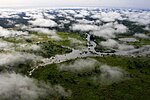
|| align="center" | Orientale,![]() عوامي جمهوريا ڪانگو
عوامي جمهوريا ڪانگو
4°00′N 29°15′E / 4°N 29.25°E || Natural:
(vii), (x) || align="center" | 500٬000 (1٬200٬000) || align="center" | 1980 || The park has vast savannas, grasslands, and woodlands, featuring elephants, giraffes, hippopotamuses, and the white rhinoceros.[54] Garamba was deemed to be endangered following the diminution of the white rhinoceros population in the area,[55] but it was removed from the list in 1991.[56] However, it later regained the status in 1996, when three rangers were killed and the population of white rhinoceros fell once again.[57][58]
|- ! scope="row" | Gebel Barkal and the Sites of the Napatan Region
|
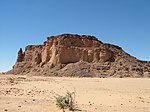
|| align="center" | Meroë,![]() سوڊان
سوڊان
18°32′00″N 31°49′00″E / 18.533333°N 31.816667°E || Cultural:
(i), (ii),
(iii), (iv), (vi) || align="center" | 183 (450) || align="center" | 2003 || The five sites in the Nile Valley feature temples that are testimonial to the Napatan and Meroitic cultures.[59]
|- ! scope="row" | Gough and Inaccessible Islands
|
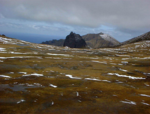
|| align="center" | Saint Helena,![]() گڏيل بادشاھت
گڏيل بادشاھت
40°19′29″S 9°55′43″W / 40.324722°S 9.928611°W || Natural:
(vii), (x) || align="center" | 7٬900 (20٬000) || align="center" | 1995[lower-alpha 4] || The site represents one of the least-disrupted islands and marine ecosystems in the South Temperate Zone. The cliffs are free of introduced mammals and feature one of the world's largest colonies of seabirds.[60]
|- ! scope="row" | Great Zimbabwe National Monument
|

|| align="center" | Masvingo Province,
![]() زمبابوي
زمبابوي
20°17′00″S 30°56′00″E / 20.283333°S 30.933333°E || Cultural:
(i), (iii), (vi) || align="center" | 722 (1٬780) || align="center" | 1986 || The city, now in ruins, was an important trading centre between the 11th and 15th centuries and was capital of the Bantu civilization.[61]
|-
! scope="row" | Harar Jugol, the Fortified Historic Town
|

|| align="center" | Harari Region,![]() ايٿوپيا
ايٿوپيا
9°18′32″N 42°08′16″E / 9.308889°N 42.137778°E || Cultural:
(ii), (iii),
(iv), (v) || align="center" | 48 (120) || align="center" | 2006 || The city is on a plateau and surrounded by gorges and savanna. It contains 82 mosques, 102 shrines, and unique interior design in the townhouses. It is said to be the fourth-holiest city of Islam.[62]
|- ! scope="row" | Historic Cairo[lower-alpha 5]
| align=center |

|| align="center" | Cairo,![]() مصر
مصر
30°03′00″N 31°15′40″E / 30.050000°N 31.261110°E || Cultural:
(i), (v), (vi) || align="center" | 524 (1٬290) || align="center" | 1979 || One of the world's oldest Islamic cities and in the middle of urban Cairo, the site dates from the 10th century and reached its golden age in the 14th century. It contains mosques, madrasahs, hammams, and fountains.[63]
|- ! scope="row" | Historic Centre of Agadez
|

|| align="center" | Tchirozerine Department,![]() نائيجر
نائيجر
16°58′25″N 7°59′29″E / 16.973611°N 7.991389°E || Cultural:
(ii), (iii) || align="center" | 78 (190) || align="center" | 2013 || [64]
|- ! scope="row" | Historic City of Meknes
|
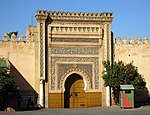
|| align="center" | Meknes,![]() مراڪش
مراڪش
33°53′00″N 5°33′30″W / 33.883330°N 5.558330°W || Cultural:
(iv) || align="center" | — || align="center" | 1996 || The former capital was founded in the 11th century and turned into a city with Spanish-Moorish influence during the 17th and 18th centuries.[65]
|- ! scope="row" | Historic Town of Grand-Bassam
|

|| align="center" | Sud-Comoé,![]() آئيوري ڪوسٽ
آئيوري ڪوسٽ
5°11′45″N 3°44′11″W / 5.195914°N 3.736369°W || Cultural:
(iii), (iv) || align="center" | 110 (270) || align="center" | 2012 || A colonial town built during the 19th and 20th centuries, Grand-Bassam was the first Ivorian capital following French rule in the region. Its quarters, which specialised in commerce, administration and general housing, helped the city become the economic and judicial hub of the country, in addition to being its most important port.[66]
|- ! scope="row" | Ichkeul National Park
|
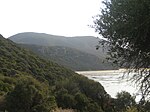
|| align="center" | Bizerte,![]() تيونس
تيونس
37°09′49″N 9°40′29″E / 37.163610°N 9.674720°E || Natural:
(x) || align="center" | 12٬600 (31٬000) || align="center" | 1980 || Ichkeul Lake and the surrounding wetlands is a destination for hundreds of thousands of migrating birds, including ducks, geese, storks, and pink flamingos. It was once part of a chain that extended across North Africa.[67] Previously, the World Heritage Committee had designated Ichkeul National Park as an endangered site in 1996, due to construction of dams that increased the salinity of the lake and reduced its ability to support bird populations.[68] In 2006 it was removed from the endangered list as the lake was no longer used for agriculture, reducing salinity and allowing birds to return.[69]
|- ! scope="row" | iSimangaliso Wetland Park[lower-alpha 6]
|
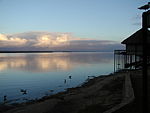
|| align="center" | KwaZulu-Natal,![]() ڏکڻ آفريقا
ڏکڻ آفريقا
27°50′20″S 32°33′00″E / 27.838890°S 32.550000°E || Natural:
(vii), (ix), (x) || align="center" | 239٬566 (591٬980) || align="center" | 1999 || The park features a variety of landforms, including coral reefs, long sandy beaches, coastal dunes, lake systems, and papyrus wetland, caused by fluvial, marine, and aeolian processes.[70]
|- ! scope="row" | Island of Gorée
|

|| align="center" | Dakar Region,![]() سينيگال
سينيگال
14°40′02″N 17°24′03″W / 14.667220°N 17.400830°W || Cultural:
(vi) || align="center" | — || align="center" | 1978 || The island was the largest slave-trading centre on the African coast from the 15th to the 19th century.[71]
|- ! scope="row" | Island of Mozambique
|

|| align="center" | Nampula,![]() موزمبيق
موزمبيق
15°02′03″S 40°44′09″E / 15.034170°S 40.735830°E || Cultural:
(iv), (vi) || align="center" | 96 (240) || align="center" | 1991 || The fortified former Portuguese trading post has used the same architectural techniques, style, and materials since the 16th century.[72]
|- ! scope="row" | Island of Saint-Louis
|
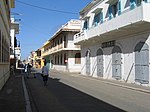
|| align="center" | Saint-Louis Region,![]() سينيگال
سينيگال
16°01′40″N 16°30′16″W / 16.027780°N 16.504440°W || Cultural:
(ii), (iv) || align="center" | — || align="center" | 2000 || The French colonial settlement from the 17th century is on an island in the mouth of the Sénégal River. It played an important role in the culture and economy of West Africa.[73]
|- ! scope="row" | Ivindo National Park
| align=center |

|| align="center" | ![]() گيبون
گيبون
0°24′22″N 12°38′27″E / 0.406111°N 12.640833°E || Natural:
(ix), (x) || align="center" | 298٬758 (738٬250) || align="center" | 2021 || The park spans a significant area characterized by a mosaic of ecosystems, including rainforests, rivers, and waterfalls, most notably Kongou and Djidji waterfalls. This protected area is home to a veriety of wildlife, including endangered species such as forest elephants, lowland gorillas, and chimpanzees. The park's rivers are vital habitats for freshwater species and play a crucial role in the conservation of aquatic biodiversity in the region.[74]
|- style="background:#FFE6BD" ! scope="row" | Kahuzi-Biega National Parkسانچو:†
| align=center |

|| align="center" | Maniema
and South Kivu,![]() عوامي جمهوريا ڪانگو
عوامي جمهوريا ڪانگو
2°30′S 28°45′E / 2.5°S 28.75°E || Natural:
(x) || align="center" | 600٬000 (1٬500٬000) || align="center" | 1980 || The park is dominated by two extinct volcanoes, Kahuzi and Biega. It also has abundant fauna, including the graueria gorillas.[75] The park was deemed to be endangered in 1997 when deforestation and hunting became a major problem. Militia groups and illegal settlers were also settling in the park, while fire and poaching helped justify the World Heritage Committee's decision.[76]
|- ! scope="row" | Kairouan
| align=center |

|| align="center" | Kairouan Governorate,![]() تيونس
تيونس
35°40′54″N 10°06′14″E / 35.681670°N 10.103890°E || Cultural:
(i), (ii),
(iii), (v), (vi) || align="center" | 68 (170) || align="center" | 1988 || The former capital was founded in 670 and flourished in the 9th century. Its heritage includes the Mosque of Uqba and the Mosque of the Three Gates.[77]
|- ! scope="row" | Kasbah of Algiers
|

|| align="center" | Algiers,![]() الجزائر
الجزائر
36°47′00″N 3°03′37″E / 36.783330°N 3.060280°E || Cultural:
(ii), (v) || align="center" | 60 (150) || align="center" | 1992 || A unique Islamic city on the Mediterranean coast, the former site overlooks the Carthaginian trading posts of the 4th century BCE. It contains remains of a citadel, old mosques, and Ottoman-style palaces.[78]
|- ! scope="row" | Kenya Lake System in the Great Rift Valley
|

|| align="center" | Rift Valley Province,![]() ڪينيا
ڪينيا
0°26′33″N 36°14′24″E / 0.442500°N 36.240000°E || Natural:
(vii), (ix),
(x) || align="center" | 32٬034 (79٬160) || align="center" | 2011 || Located in the Great Rift Valley, Kenya, the site features three lakes: Lake Bogoria, Lake Nakuru, and Lake Elementaita. A highly diverse population of birds, including thirteen threatened species, frequent the area.[79]
|- ! scope="row" | Khami Ruins National Monument
|

|| align="center" | Matabeleland,
![]() زمبابوي
زمبابوي
20°09′30″S 28°22′36″E / 20.158333°S 28.376667°E || Cultural:
(iii), (iv) || align="center" | — || align="center" | 1986 || The city was built after the mid-16th century and was an important trading centre.[80]
|-
! scope="row" | ǂKhomani Cultural Landscape
| || align="center" | Northern Cape,![]() ڏکڻ آفريقا
ڏکڻ آفريقا
25°41′15″S 20°22′29″E / 25.68761111111111°S 20.374583333333334°E || Cultural:
(v), (vi) || align="center" | 959٬100 (2٬370٬000) || align="center" | 2017 || "The ǂKhomani Cultural Landscape is located at the border with Botswana and Namibia in the northern part of the country, coinciding with the Kalahari Gemsbok National Park (KGNP). The large expanse of sand contains evidence of human occupation from the Stone Age to the present and is associated with the culture of the formerly nomadic ǂKhomani San people and the strategies that allowed them to adapt to harsh desert conditions."[81]
|-
! scope="row" | Kilimanjaro National Park
|

|| align="center" | Kilimanjaro Region,
سانچو:Country data Tanzania, United Republic of
3°04′00″S 37°22′00″E / 3.066670°S 37.366670°E || Natural:
(vii) || align="center" | 75٬575 (186٬750) || align="center" | 1987 || The volcanic massif Mount Kilimanjaro is Africa's highest point at 5٬895 ميٽر (19٬341 ft) and is surrounded by a park with savanna and forest featuring numerous mammals.[82]
|- ! scope="row" | Kondoa Rock-Art Sites
| align=center |

|| align="center" | Kondoa district,
سانچو:Country data Tanzania, United Republic of
4°43′28″S 35°50′02″E / 4.724444°S 35.833889°E || Cultural:
(iii), (vi) || align="center" | 233٬600 (577٬000) || align="center" | 2006 || Two millennia of rock carvings, many of high artistic value, have been found at 150 shelters in the site. They tell the tale of socio-economic development from hunter-gatherer to agro-pastoralism.[83]
|- ! scope="row" | Konso Cultural Landscape
| align=center |

|| align="center" | Southern Nations, Nationalities, and People's Region,![]() ايٿوپيا
ايٿوپيا
5°18′N 37°24′E / 5.3°N 37.4°E || Cultural:
(iii), (v) || align="center" | 23٬000 (57٬000) || align="center" | 2011 || The site features 55 ڪلوميٽر (34 mi) of stonewalled terraces and fortified settlements in the Konso highlands of Ethiopia.[84]
|- ! scope="row" | Koutammakou, the Land of the Batammariba*
|
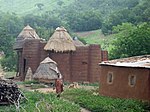
|| style="background:#D0E7FF" align="center" | ![]() بینن*;
بینن*;![]() ٽوگو*
ٽوگو*
10°04′00″N 1°08′00″E / 10.066667°N 1.133333°E || Cultural:
(v), (vi) || align="center" | 50٬000 (120٬000) || align="center" | 2004 || The site covers the Batammariba people's transnational cultural landscape, including sacred spaces and distinctive mud tower-house architecture.[85]
|- ! scope="row" | Ksar of Ait-Ben-Haddou
|
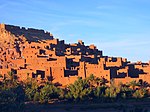
|| align="center" | Aït Benhaddou,![]() مراڪش
مراڪش
31°02′50″N 7°07′44″W / 31.047220°N 7.128890°W || Cultural:
(iv), (v) || align="center" | 3 (7.4) || align="center" | 1987 || The ksar is an example of a traditional pre-Saharan habitat, surrounded by high walls and reinforced with corner towers.[86]
|- ! scope="row" | Kunta Kinteh Island and Related Sites[lower-alpha 7]
|

|| align="center" | Banjul,
Lower Niumi,
and Upper Niumi,![]() گيمبيا
گيمبيا
13°18′58″N 16°21′26″W / 13.316166°N 16.357194°W || Cultural:
(iii), (vi) || align="center" | 8 (20) || align="center" | 2003 || The site is a testimony to the encounters between Africa and Europe from pre-colonial times to independence along the Gambia River.[87]
|- ! scope="row" | Lake Malawi National Park
|

|| align="center" | Central Region
and Southern Region,![]() ملاوي
ملاوي
14°02′00″S 34°53′00″E / 14.033330°S 34.883330°E || Natural:
(vii), (ix), (x) || align="center" | 9٬400 (23٬000) || align="center" | 1984 || Lake Malawi contains hundreds of fish species, mostly endemic.[88]
|- ! scope="row" | Lakes of Ounianga
|

|| align="center" | Ennedi Region,![]() چاڊ
چاڊ
19°03′18″N 20°30′20″E / 19.055000°N 20.505556°E || Natural:
(vii) || align="center" | 62٬808 (155٬200) || align="center" | 2012 || The Lakes of Ounianga are a series of 18 lakes located in the Sahara desert, in North-Eastern Chad. They exhibit a variety of sizes, depths, chemical compositions, and colourations, and some of them are home to aquatic fauna.[89]
|- style="background:#FFE6BD" ! scope="row" | Lake Turkana National Parksسانچو:†
|

|| align="center" | Lake Turkana,![]() ڪينيا
ڪينيا
3°03′05″N 36°30′13″E / 3.051306°N 36.503667°E || Natural:
(viii), (x) || align="center" | 161٬485 (399٬040) || align="center" | 1997[lower-alpha 8] || Turkana, as Africa's largest saline lake, is an important area for the study of fauna and flora. It is a breeding ground for the Nile crocodile, hippopotamus, and several venomous snakes.[90] The site was placed the List of World Heritage in Danger in 2018, primarily due to the potential impact of Ethiopia's Gilgel Gibe III Dam.[91]
|- ! scope="row" | Lamu Old Town
| align=center |

|| align="center" | Lamu,![]() ڪينيا
ڪينيا
2°16′05″S 40°54′07″E / 2.268°S 40.902°E || Cultural:
(ii), (iv), (vi) || align="center" | 16 (40) || align="center" | 2001 || The town is the oldest Swahili settlement and is built in coral stone and mangrove timber. It features inner courtyards, verandas, and elaborate wooden doors.[92]
|- ! scope="row" | Laurisilva of Madeira
|

|| align="center" | Madeira,![]() پورچوگال
پورچوگال
32°46′00″N 17°00′00″W / 32.766667°N 17°W || Natural:
(ix), (x) || align="center" | 15٬000 (37٬000) || align="center" | 1999 || The site is the largest surviving area of laurel forest. It consists of approximately 90% old-growth forest and is home to endemic species such as the Madeiran long-toed pigeon.[93]
|- ! scope="row" | Le Morne Cultural Landscape
|

|| align="center" | Rivière Noire District,![]() موريشس
موريشس
20°27′07″S 57°19′42″E / 20.451944°S 57.328333°E || Cultural:
(iii), (vi) || align="center" | 349 (860) || align="center" | 2008 || The rugged mountain that juts into the ocean was used as a shelter by runaway slaves through the 18th and early 19th centuries. They formed small settlements in the caves and on its summit.[94]
|- ! scope="row" | Lower Valley of the Awash
| align=center |
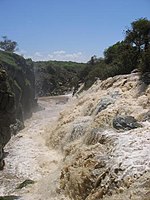
|| align="center" | Afar Region,![]() ايٿوپيا
ايٿوپيا
11°06′00″N 40°34′46″E / 11.100060°N 40.579390°E || Cultural:
(ii), (iii), (iv) || align="center" | — || align="center" | 1980 || Palaeontological findings from at least four million years ago, such as Lucy, give evidence of human evolution.[95]
|- ! scope="row" | Lower Valley of the Omo
| align=center |
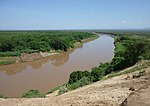
|| align="center" | Southern Nations, Nationalities, and People's Region,![]() ايٿوپيا
ايٿوپيا
4°48′00″N 35°58′00″E / 4.8°N 35.966667°E || Cultural:
(iii), (iv) || align="center" | — || align="center" | 1980 || The prehistoric site near Lake Turkana is the location of many fossil findings, such as Homo gracilis.[96]
|- ! scope="row" | M'Zab Valley
|

|| align="center" | Ghardaïa,![]() الجزائر
الجزائر
32°29′00″N 3°41′00″E / 32.483330°N 3.683330°E || Cultural:
(ii), (iii), (v) || align="center" | 665 (1٬640) || align="center" | 1982 || The intact, traditional human habitat was built around five ksour in the 10th century by the Ibadites.[97]
|- ! scope="row" | Maloti-Drakensberg Park
|

|| style="background:#D0E7FF" align="center" | Qacha's Nek District,![]() ليسوٿو*;
ليسوٿو*;
KwaZulu-Natal,![]() ڏکڻ آفريقا*
ڏکڻ آفريقا*
29°45′55″S 29°07′23″E / 29.765278°S 29.123056°E || Mixed:
(i), (iii),
(vii), (x) || align="center" | 249٬313 (616٬070) || align="center" | 2000 || The park features incisive dramatic cutbacks, golden sandstone ramparts, and the largest concentration of cave art in Sub-Saharan Africa.[98]
|- ! scope="row" | Mana Pools National Park, Sapi and Chewore Safari Areas
| align="center" |
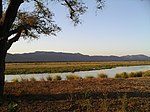
|| align="center" | Mashonaland West,
![]() زمبابوي
زمبابوي
15°49′10″S 29°24′29″E / 15.819444°S 29.408056°E || Natural:
(vii), (ix), (x) || align="center" | 676٬600 (1٬672٬000) || align="center" | 1984 || The park, located on the banks of the Zambezi River, features a variety of wild animals, such as buffalo, leopards, cheetahs, and Nile crocodiles.[99]
|- style="background:#FFE6BD"
! scope="row" | Manovo-Gounda St Floris National Parkسانچو:†
| || align="center" | Bamingui-Bangoran,![]() وسطي آفريقي جمهوريا
وسطي آفريقي جمهوريا
9°00′N 21°30′E / 9°N 21.5°E || Natural:
(ix), (x) || align="center" | 1٬740٬000 (4٬300٬000) || align="center" | 1988 || The park features vast savannas with a wealth of flora and fauna, such as black rhinoceros, elephants, cheetahs, leopards, wild dogs, red-fronted gazelles, and buffalo.[100] The site was placed on the List of World Heritage in Danger in 1997 due to grazing and poaching that is thought to have claimed 80% of the wildlife in the park. Also cited was the shooting of four park staff and "a general state of deteriorating security".[101]
|-
! scope="row" | Mapungubwe Cultural Landscape
| align="center" |
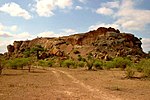
|| align="center" | Limpopo,![]() ڏکڻ آفريقا
ڏکڻ آفريقا
22°11′33″S 29°14′20″E / 22.192500°S 29.238890°E || Cultural:
(ii), (iii),
(iv), (v) || align="center" | 28٬168 (69٬600) || align="center" | 2003 || The open savanna landscape lies at the confluence of the Limpopo and Shashe Rivers. It was the heart of the Mapungubwe Kingdom until the 14th century, when the area was abandoned, leaving untouched remains of palaces and settlements.[102]
|- ! scope="row" | Matobo Hills
| align=center |

|| align="center" | Matabeleland South,
![]() زمبابوي
زمبابوي
20°30′S 28°30′E / 20.5°S 28.5°E || Cultural:
(iii), (v), (vi) || align="center" | 205٬000 (510٬000) || align="center" | 2003 || The large boulders have been used as natural shelters since the early Stone Age and feature a collection of rock paintings.[103]
|-
! scope="row" | Mbanza Kongo, Vestiges of the Capital of the former Kingdom of Kongo
| align=center |

|| align="center" | Zaire Province,![]() انگولا
انگولا
6°16′04″S 14°14′53″E / 6.267778°S 14.248056°E || Cultural:
(iii), (iv) || align="center" | 89.29 (220.6) || align="center" | 2017 || The town of Mbanza Kongo was the "political and spiritual capital of the Kingdom of Kongo," displaying a mix of Kongolese and Portuguese-style architecture.[104]
|- ! scope="row" | Medina of Essaouira (formerly Mogador)
| align=center |

|| align="center" | Essaouira,![]() مراڪش
مراڪش
31°31′00″N 9°46′10″W / 31.516670°N 9.769440°W || Cultural:
(ii), (iv) || align="center" | 57 (140) || align="center" | 2001 || The fortified seaport built during the late 18th century has a mix of North African and European architecture and was a major trading hub between the Sahara and Europe.[105]
|- ! scope="row" | Medina of Fez
| align="center" |
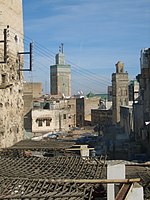
|| align="center" | Fez,![]() مراڪش
مراڪش
34°03′40″N 4°58′40″W / 34.061110°N 4.977780°W || Cultural:
(ii), (v) || align="center" | 280 (690) || align="center" | 1981 || The former capital was founded in the 9th century and features the world's oldest university. The urban fabric and main monuments date from the 13th and 14th centuries.[106]
|- ! scope="row" | Medina of Marrakesh
| align=center |
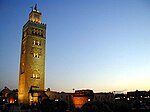
|| align="center" | Marrakesh,![]() مراڪش
مراڪش
31°37′53″N 7°59′12″W / 31.631390°N 7.986670°W || Cultural:
(i), (ii),
(iv), (v) || align="center" | 1٬107 (2٬740) || align="center" | 1985 || The town was founded in the 1070s and remained a political, economic, and cultural centre for a long time. Monuments from that period include the Koutoubia Mosque, the kasbah, and the battlements. The city also holds newer features, including palaces.[107]
|- ! scope="row" | Medina of Sousse
|
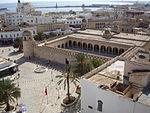
|| align="center" | Sousse Governorate,![]() تيونس
تيونس
35°49′40″N 10°38′19″E / 35.827780°N 10.638610°E || Cultural:
(iii), (iv), (v) || align="center" | 32 (79) || align="center" | 1988 || A prime example of a town from the early Islamic period, the city was an important port during the 9th century.[108]
|- ! scope="row" | Medina of Tétouan (formerly known as Titawin)
|
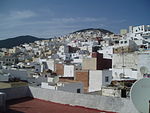
|| align="center" | Tétouan,![]() مراڪش
مراڪش
35°34′15″N 5°22′00″W / 35.570830°N 5.366670°W || Cultural:
(ii), (iv), (v) || align="center" | 7 (17) || align="center" | 1997 || Morocco's most complete medina served as the main point of contact between Morocco and Andalusia during the 8th century. The town was rebuilt by Andalusian refugees following the reconquista.[109]
|- ! scope="row" | Medina of Tunis
|

|| align="center" | Tunis,![]() تيونس
تيونس
36°49′00″N 10°10′00″E / 36.816670°N 10.166670°E || Cultural:
(ii), (iii), (v) || align="center" | 296 (730) || align="center" | 1979 || The medina holds 700 monuments, including palaces, mosques, mausoleums, madrasahs, and fountains, testifying to Tunis's golden age from the 12th to the 16th century.[110]
|- ! scope="row" | Memphis and its Necropolis – the Pyramid Fields from Giza to Dahshur
|

|| align="center" | Giza,![]() مصر
مصر
29°58′34″N 31°07′49″E / 29.976040°N 31.130410°E || Cultural:
(i), (iii), (vi) || align="center" | 16٬358 (40٬420) || align="center" | 1979 || The former capital features funerary monuments, like rock tombs, mastabas, temples, and pyramids. It is one of the Seven Wonders of the Ancient World.[111]
|- ! scope="row" | Mosi-oa-Tunya / Victoria Falls
|

|| style="background:#D0E7FF" align="center" | Livingstone District
and Matabeleland North,![]() زيمبيا*;
زيمبيا*;
![]() زمبابوي*
زمبابوي*
17°55′28″S 25°51′19″E / 17.924530°S 25.855390°E || Natural:
(vii), (viii) || align="center" | 6٬860 (17٬000) || align="center" | 1989 || The falls of the Zambezi River, which is more than 2 km (1.2 mi) wide, plunge down various basalt gorges resulting in a colourful mist.[112]
|-
! scope="row" | Mount Kenya National Park/Natural Forest
|

|| align="center" | Central Province
and Eastern Province,![]() ڪينيا
ڪينيا
0°09′18″N 37°18′56″E / 0.155000°N 37.315556°E || Natural:
(vii), (ix) || align="center" | 202٬334 (499٬980) || align="center" | 1997[lower-alpha 9] || The park surrounds the 5٬199 m (17٬057 ft) Mount Kenya and features twelve glaciers.[113]
|- style="background:#FFE6BD" ! scope="row" | Mount Nimba Strict Nature Reserveسانچو:†
|
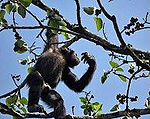
|| align="center" style="background-color: #D0E7FF" | Lola Prefecture,![]() آئيوري ڪوسٽ*;
آئيوري ڪوسٽ*;![]() گائينا*
گائينا*
7°36′11″N 8°23′27″W / 7.603180°N 8.390970°W || Natural:
(ix), (x) || align="center" | 17٬540 (43٬300) || align="center" | 1981[lower-alpha 10] || The reserve features Mount Nimba, its slopes covered in dense forest and grassy mountain pastures.[114] In 1992, the park was inscribed on the World Heritage Committee's danger list, citing a proposed iron and ore mining concession inside the park's boundaries and the apparition of refugees. The state party later stated that there was an error with the proposed mining site's boundaries and that it was not in the reserve.[115] However, as of 2019, the site remains on the list due to mining activity near the site.[116]
|- ! scope="row" | Namib Sand Sea
|

|| align="center" | ![]() نميبيا
نميبيا
24°53′07″S 15°24′28″E / 24.885278°S 15.407778°E || Natural:
(vii), (viii), (ix), (x) || align="center" | 3٬077٬700 (7٬605٬000) || align="center" | 2013 || Characterized by dynamic and extensive dune fields, which are among the oldest and largest in the world. The Namib Sand Sea is notable for its unique ecosystem, which has adapted to extreme arid conditions, including a variety of endemic species that rely on fog as a primary source of moisture. [117]
|- ! scope="row" | Ngorongoro Conservation Area
|

|| align="center" | Arusha Region,
سانچو:Country data Tanzania, United Republic of
3°11′14″S 35°32′27″E / 3.187220°S 35.540830°E || Mixed:
(iv)[lower-alpha 11], (vii),
(viii), (ix), (x) || align="center" | 809٬440 (2٬000٬200) || align="center" | 1979 || The site features a concentration of wild animals in a crater beside the active volcano Oldonyo Lengai.[118] Ngorongoro was previously on the danger list from 1984 to 1989 due to decreased conservation and poor management.[119][120]
|- style="background:#FFE6BD" ! scope="row" | Niokolo-Koba National Parkسانچو:†
|

|| align="center" | Kédougou Region
and Tambacounda Region,![]() سينيگال
سينيگال
13°04′00″N 12°43′00″W / 13.066670°N 12.716670°W || Natural:
(x) || align="center" | 913٬000 (2٬260٬000) || align="center" | 1981 || The forests and savannas bordering the Gambia River have a diverse fauna, including Derby eland, chimpanzees, lions, birds, reptiles, and amphibians.[121] The park was listed as being endangered in 2007 for low mammal populations, the construction of a dam, and management problems.[122]
|- ! scope="row" | Nubian Monuments from Abu Simbel to Philae
|

|| align="center" | Aswan,![]() مصر
مصر
22°20′11″N 31°37′34″E / 22.336390°N 31.626110°E || Cultural:
(i), (iii), (vi) || align="center" | 374 (920) || align="center" | 1979 || Located along the Nile, the site contains monuments such as the Temple of Ramesses II and the Sanctuary of Isis.[123]
|- style="background:#FFE6BD" ! scope="row" | Okapi Wildlife Reserveسانچو:†
|

|| align="center" | Orientale,![]() عوامي جمهوريا ڪانگو
عوامي جمهوريا ڪانگو
2°00′N 28°30′E / 2°N 28.5°E || Natural:
(x) || align="center" | 1٬372٬625 (3٬391٬830) || align="center" | 1996 || Covering a fifth of the Ituri Rainforest in the Congo River basin, the reserve contains many threatened species of primates and birds. It is inhabited by the nomadic pygmy Mbuti and Efé tribes.[124] In 1997, looting, the killing of elephants, and the departure of reserve staff led the World Heritage Committee to place the reserve on its List of World Heritage in Danger, only a year following its inscription as a natural heritage site.[125]
|- ! scope="row" | Okavango Delta
|

|| align="center" | Okavango,![]() بوٽسوانا
بوٽسوانا
19°17′00″S 22°54′00″E / 19.283333°S 22.9°E || Natural:
(vii), (ix), (x) || align="center" | 2٬023٬590 (5٬000٬400) || align="center" | 2014 || One of the world's largest inland deltas, formed where the Okavango River empties onto a basin in the Kalahari Desert. This nearly intact ecosystem is characterized by seasonal flooding, which transforms the landscape into a mosaic of water channels, lagoons, and islands that house an exceptional variety of wildlife.[126]
|- style="background:#FFE6BD" ! scope="row" | Old Towns of Djennéسانچو:†
|
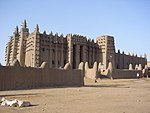
|| align="center" | Djenné,![]() مالي
مالي
13°54′23″N 4°33′18″W / 13.906390°N 4.555000°W || Cultural:
(iii), (iv) || align="center" | — || align="center" | 1988 || Inhabited since 250 BCE, the city was an important link in the trans-Saharan gold trade. It contains 2,000 traditional houses.[127] Djenné was placed on UNESCO's List of World Heritage in Danger in 2016, due to deterioration, urbanization, and erosion of the site.[128]
|- style="background:#FFE6BD" ! scope="row" | Old Town of Ghadamèsسانچو:†
|
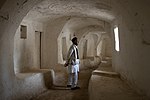
|| align="center" | Ghadames,![]() لبيا
لبيا
30°08′00″N 9°30′00″E / 30.133333°N 9.5°E || Cultural:
(v) || align="center" | 38 (94) || align="center" | 1986 || Located in an oasis, Ghadames is one of the oldest pre-Saharan cities and represents a traditional architecture with vertical division of functions.[129] All five sites in Libya, including Ghadames, were placed on UNESCO's List of World Heritage in Danger in 2016, due to ongoing conflict in the country.[130]
|- ! scope="row" | Osun-Osogbo Sacred Grove
| align=center |

|| align="center" | Osogbo,![]() نائجيريا
نائجيريا
7°45′20″N 4°33′08″E / 7.755560°N 4.552220°E || Cultural:
(ii), (iii), (vi) || align="center" | 75 (190) || align="center" | 2005 || The dense forests are one of the final remnants of high forests in southern Nigeria. It is the last sacred grove of the Yoruba culture.[131]
|- ! scope="row" | Pitons, cirques and remparts of Reunion Island
|

|| align="center" | La Réunion,![]() فرانس
فرانس
21°05′58″S 55°28′48″E / 21.099444°S 55.480000°E || Natural:
(vii), (x) || align="center" | 105٬838 (261٬530) || align="center" | 2010 || Outstanding terrain and biodiversity, as part of La Réunion National Park.[132]
|- ! scope="row" | Portuguese City of Mazagan (El Jadida)
|

|| align="center" | El Jadida,![]() مراڪش
مراڪش
33°15′24″N 8°30′07″W / 33.256670°N 8.501940°W || Cultural:
(ii), (iv) || align="center" | 8 (20) || align="center" | 2004 || The fortification, akin to Renaissance military design from the early 16th century, was taken over by Morocco in 1769. Surviving buildings include the cistern and a Gothic church.[133]
|- ! scope="row" | Punic Town of Kerkuane and its Necropolis
|

|| align="center" | Nabeul Governorate,![]() تيونس
تيونس
36°56′47″N 11°05′57″E / 36.946390°N 11.099170°E || Cultural:
(iii) || align="center" | 0.11 (0.27) || align="center" | 1985[lower-alpha 12] || The city was abandoned in 250 BCE during the First Punic War and is the only surviving example of a Phoenicio–Punic settlement.[134]
|- ! scope="row" | Rabat, Modern Capital and Historic City: a Shared Heritage
| align=center |

|| align="center" | Rabat-Salé-Zemmour-Zaer,![]() مراڪش
مراڪش
34°01′27″N 6°49′22″W / 34.024167°N 6.822778°W || Cultural:
(ii), (iv) || align="center" | 349 (860) || align="center" | 2012 || Rebuilt under the direction of the French from 1912 to the 1930s, the city blends historic and modern features, such as botanical gardens, the Hassan Mosque, and the remnants of Moorish and Andalusian settlements from the 17th century.[135]
|- style="background:#FFE6BD" ! scope="row" | Rainforests of the Atsinananaسانچو:†
| align=center |

|| align="center" | Eastern Madagascar,![]() مڊگاسڪر
مڊگاسڪر
14°27′35″S 49°42′09″E / 14.459722°S 49.702500°E || Natural:
(ix), (x) || align="center" | 479٬660 (1٬185٬300) || align="center" | 2007 || The site consists of six national parks and protects the island's unique biodiversity, which has evolved in isolation for 60 million years.[136] The park was deemed to be in danger in 2010, when logging and hunting activities continued to escalate, despite a ban by Madagascar on exporting illegal timber.[137]
|- ! scope="row" | Richtersveld Cultural and Botanical Landscape
|

|| align="center" | Northern Cape,![]() ڏکڻ آفريقا
ڏکڻ آفريقا
28°36′00″S 17°12′14″E / 28.6°S 17.203889°E || Cultural:
(iv), (v) || align="center" | 160٬000 (400٬000) || align="center" | 2007 || The mountainous desert sustains the semi-nomadic livelihood of the Nama, which includes seasonal migrations that have gone unchanged for two millennia.[138]
|- ! scope="row" | Risco Caido and the Sacred Mountains of Gran Canaria Cultural Landscape
| align=center |

|| align="center" | Risco Caído,![]() اسپين
اسپين
28°02′40″N 15°39′40″W / 28.0443889°N 015.6611944°W || Cultural:
(iii), (v) || align="center" | 9٬425 (23٬290) || align="center" | 2019 || [139]
|- ! scope="row" | Robben Island
|

|| align="center" | Western Cape,![]() ڏکڻ آفريقا
ڏکڻ آفريقا
33°48′00″S 18°22′00″E / 33.8°S 18.366667°E || Cultural:
(iii), (vi) || align="center" | 475 (1٬170) || align="center" | 1999 || Between the 17th and 20th century, the island was used as a prison, including for political prisoners, a hospital for socially unacceptable groups, and a military base.[140]
|- style="background:#FFE6BD" ! scope="row" | Rock-Art Sites of Tadrart Acacusسانچو:†
|
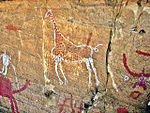
|| align="center" | Fezzan,![]() لبيا
لبيا
24°50′00″N 10°20′00″E / 24.833330°N 10.333330°E || Cultural:
(iii) || align="center" | 3٬923٬961 (9٬696٬320) || align="center" | 1985 || Thousands of cave paintings are visible in different styles, dating from 12,000 BCE to 100 CE.[141] All five sites in Libya, including Tadrart Acacus, were placed on UNESCO's List of World Heritage in Danger in 2016, due to ongoing conflict in the country.[142]
|- ! scope="row" | Rock-Hewn Churches, Lalibela
| align=center |
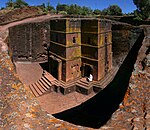
|| align="center" | Amhara Region,![]() ايٿوپيا
ايٿوپيا
12°01′46″N 39°02′26″E / 12.029350°N 39.040420°E || Cultural:
(i), (ii), (iii) || align="center" | — || align="center" | 1978 || The site contains eleven medieval cave churches from the 13th century.[143]
|- ! scope="row" | Royal Hill of Ambohimanga
|

|| align="center" | Antananarivo,![]() مڊگاسڪر
مڊگاسڪر
18°45′33″S 47°33′46″E / 18.759170°S 47.562780°E || Cultural:
(iii), (iv), (vi) || align="center" | 59 (150) || align="center" | 2001 || The royal city and burial site is a spiritual and sacred site which has created strong feelings of national identity for several centuries.[144]
|- ! scope="row" | Royal Palaces of Abomey
|
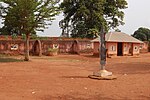
|| align="center" | Zou Department,![]() بینن
بینن
7°11′00″N 1°59′00″E / 7.183333°N 1.983333°E || Cultural:
(iii), (iv) || align="center" | 48 (120) || align="center" | 1985 || The city held the seat of twelve kings who ruled the Kingdom of Dahomey between 1625 and 1900. All but one king built their palace within the area.[145] The site was originally classified as endangered from its inception in 1985 due to extensive damage caused by a tornado,[146] but was later removed from the list in 2007.[147]
|- ! scope="row" | Ruins of Kilwa Kisiwani and Ruins of Songo Mnara
| align=center |
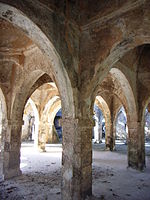
|| align="center" | Kilwa District,
سانچو:Country data Tanzania, United Republic of
8°57′28″S 39°31′22″E / 8.957780°S 39.522780°E || Cultural:
(iii) || align="center" | — || align="center" | 1981 || The site features the remains of two ports used extensively for trade across the Indian Ocean from the 13th through 16th centuries.[148] It was placed onto the List of World Heritage in Danger by the World Heritage Committee in 2004, citing "the continuing deterioration and the serious threats affecting the property of the Ruins of Kilwa Kisiwani and Songo Mnara".[149] Conditions subsequently improved and the site was removed from the World Heritage in Danger list in 2014.[150]
|- ! scope="row" | Ruins of Loropéni
|

|| align="center" | Loropéni,![]() برڪينا فاسو
برڪينا فاسو
10°15′00″N 3°35′00″W / 10.25°N 3.583333°W || Cultural:
(iii) || align="center" | 1.1 (2.7) || align="center" | 2009 || More than a thousand years old, Loropéni is the best-preserved of ten fortresses in Lobi, which were part of about a hundred stone enclosures built during the trans-Saharan gold trade.[151]
|- ! scope="row" | Rwenzori Mountains National Park
|

|| align="center" | Bundibugyo District,
Kabarole District,
and Kasese District,![]() يوگينڊا
يوگينڊا
0°13′25″N 29°55′27″E / 0.223611°N 29.924167°E || Natural:
(vii), (x) || align="center" | 99٬600 (246٬000) || align="center" | 1994 || Covering most of the Rwenzori Mountains, including Mount Margherita, Africa's third-highest peak, the park features glaciers, waterfalls, and lakes in an alpine landscape. It also features various endangered species and unusual flora.[152] The park was previously listed as endangered from 1999 through 2004 due to general lack of security and conservation.[153][154]
|- ! scope="row" | Sacred Mijikenda Kaya Forests
| align=center |

|| align="center" | Coast Province,![]() ڪينيا
ڪينيا
3°55′55″S 39°35′46″E / 3.931944°S 39.596111°E || Cultural:
(iii), (v), (vi) || align="center" | 1٬538 (3٬800) || align="center" | 2008 || The site comprises eleven forests spread 200 km (120 mi) along the coast of Kenya. They hold the remains of villages built during the 16th century by the Mijikenda and are now considered sacred sites.[155]
|- ! scope="row" | Saint Catherine Area
|
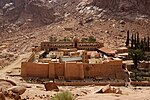
|| align="center" | South Sinai Governorate,![]() مصر
مصر
28°33′22″N 33°58′32″E / 28.556230°N 33.975430°E || Cultural:
(i), (iii),
(iv), (vi) || align="center" | 60٬100 (149٬000) || align="center" | 2002 || The orthodox monastery from the 6th century is positioned near Mount Horeb where, according to the Old Testament, Moses received the Tablets of the Law. The region is sacred for Christians, Muslims, and Jews.[156]
|- ! scope="row" | Salonga National Park
|

|| align="center" | Maniema
and South Kivu,![]() عوامي جمهوريا ڪانگو
عوامي جمهوريا ڪانگو
2°S 21°E / 2°S 21°E || Natural:
(vii), (ix) || align="center" | 3٬600٬000 (8٬900٬000) || align="center" | 1984 || Africa's largest tropical rain forest reserve is situated at the heart of the Congo River basin and only accessible by water. It is the habitat of endangered species such as the bonobo, the Congo peafowl, the forest elephant, and the slender-snouted crocodile.[157] The site was deemed to be in danger in 1999, due to increased poaching activities and encroachments.[158] However, this categorization was eventually removed in 2021 due to increased conservation efforts.[159]
|- ! scope="row" | Saloum Delta
|

|| align="center" | ![]() سينيگال
سينيگال
13°50′07″N 16°29′55″W / 13.835278°N 16.498611°W || Cultural:
(iii), (iv), (v) || align="center" | 145٬811 (360٬310) || align="center" | 2011 || The area has sustained human life thanks to fishing and shellfish gathering, for which there are 218 shellfish mounds across the site.[160]
|-
! scope="row" | Sanganeb Marine National Park and Dungonab Bay – Mukkawar Island Marine National Park
| || align="center" | ![]() سوڊان
سوڊان
19°44′10″N 37°26′35″E / 19.73611°N 37.44306°E || Natural:
(vii), (ix), (x) || align="center" | 260٬700 (644٬000) || align="center" | 2016 || Situated in the central Red Sea, Sanganeb, Dungonab Bay, and Mukkawar Island feature a diverse system of coral reefs, mangroves, seagrass beds, beaches, and islets. They host populations of seabirds, marine mammals, fish, sharks, turtles, manta rays, and dugongs.[161]
|-
! scope="row" | San Cristóbal de la Laguna
|

|| align="center" | Province of Santa Cruz de Tenerife,![]() اسپين
اسپين
28°28′40″N 16°18′42″W / 28.477889°N 16.311778°W || Cultural:
(ii), (iv) || align="center" | 60 (150) || align="center" | 1999 || The city contains two centres: the unplanned Upper Town; and the planned Lower Town, laid out according to philosophical principles. Many of the buildings date from the 16th to the 18th centuries.[162]
|- ! scope="row" | Sangha Trinational
|
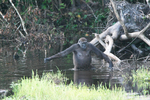
|| style="background:#D0E7FF" align="center" | ![]() ڪيمرون*;
ڪيمرون*;![]() وسطي آفريقي جمهوريا*;
وسطي آفريقي جمهوريا*;![]() جمهوريا ڪانگو*
جمهوريا ڪانگو*
2°36′34″N 16°33′15″E / 2.609444°N 16.554167°E || Natural:
(ix), (x) || align="center" | 746٬309 (1٬844٬170) || align="center" | 2012 || This area encompasses national parks and reserves including Nouabalé-Ndoki National Park in Congo, Lobéké National Park in Cameroon, and Dzanga-Ndoki National Park in the Central African Republic. The Sangha Trinational is celebrated for its exceptional biodiversity, the area also supports the traditional and sustainable livelihoods of indigenous peoples, including the Ba'Aka pygmies, who have lived in harmony with this forest for thousands of years. [163]
|- style="background:#FFE6BD" ! scope="row" | Selous Game Reserveسانچو:†
|

|| align="center" | Lindi Region,
Morogoro Region,
Mtwara Region,
Pwani Region,
and Ruvuma Region,
سانچو:Country data Tanzania, United Republic of
9°00′S 37°24′E / 9°S 37.4°E || Natural:
(ix), (x) || align="center" | 5٬120٬000 (12٬700٬000) || align="center" | 1982 || The park's vegetation varies from dense thickets to open wooded grasslands and features large numbers of elephants, black rhinoceros, cheetahs, giraffes, hippos, and crocodiles.[164] It was placed onto the List of World Heritage in Danger by the World Heritage Committee in 2014 due to widespread poaching, especially of elephants and rhinoceros.[165]
|- ! scope="row" | Serengeti National Park
|

|| align="center" | Arusha Region,
Mara Region,
and Shinyanga Region,
سانچو:Country data Tanzania, United Republic of
2°20′00″S 34°34′00″E / 2.333330°S 34.566670°E || Natural:
(vii), (x) || align="center" | 1٬476٬300 (3٬648٬000) || align="center" | 1981 || The vast savanna is known for the annual migration for herds of wildebeest, gazelle, zebras, and their predators.[166]
|- ! scope="row" | Simien National Park
|
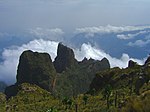
|| align="center" | Amhara Region,![]() ايٿوپيا
ايٿوپيا
13°11′00″N 38°04′00″E / 13.183333°N 38.066667°E || Natural:
(vii), (x) || align="center" | 13٬600 (34٬000) || align="center" | 1978 || The eroded Ethiopian plateau comprises jagged mountain peaks, deep valleys, and sharp precipices dropping about 1٬500 m (4٬900 ft).[167] The decrease of the walia ibex, bushbuck, and bushpig populations, as well as an increase of the human population in the park, prompted the World Heritage Committee to place it on their List of World Heritage in Danger in 1996.[168] However, the park was removed from the danger list in 2017 after improvements in management and reduction of overgrazing.[169]
|- ! scope="row" | Stone Circles of Senegambia
|
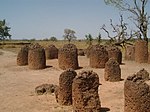
|| style="background:#D0E7FF" align="center" | Central River Division
and Kaolack Region,![]() گيمبيا*;
گيمبيا*;![]() سينيگال*
سينيگال*
13°41′28″N 15°31′21″W / 13.691111°N 15.522500°W || Cultural:
(i), (iii) || align="center" | 10 (25) || align="center" | 2006 || The groups of stone circles are among over 1,000 different monuments along the Gambia River. Used as burial grounds, they were erected between the 3rd century BCE and the 16th century CE.[170]
|- ! scope="row" | Stone Town of Zanzibar
|

|| align="center" | Zanzibar,
سانچو:Country data Tanzania, United Republic of
6°09′47″S 39°11′21″E / 6.163060°S 39.189170°E || Cultural:
(ii), (iii), (vi) || align="center" | 96 (240) || align="center" | 2000 || A prime example of an East African coastal trading town, its urban fabric and townscape remain intact.[171]
|-
! scope="row" | Sudanese style mosques in northern Côte d’Ivoire
| || align="center" | ![]() آئيوري ڪوسٽ
آئيوري ڪوسٽ
10°29′25″N 6°24′37″W / 10.490317°N 6.410167°W || Cultural:
(ii), (iv) || align="center" | 0.13 (0.32) || align="center" | 2021 || [172]
|-
! scope="row" | Sukur Cultural Landscape
|

|| align="center" | Madagali,![]() نائجيريا
نائجيريا
10°44′26″N 13°34′19″E / 10.740560°N 13.571940°E || Cultural:
(iii), (v), (vi) || align="center" | 764 (1٬890) || align="center" | 1999 || The site features the Palace of the Hidi, terraced fields, and the remains of a former iron industry.[173]
|- ! scope="row" | Taï National Park
| align="center" |

|| align="center" | Guiglo
and Sassandra,![]() آئيوري ڪوسٽ
آئيوري ڪوسٽ
5°45′00″N 7°07′00″W / 5.750000°N 7.116667°W || Natural:
(vii), (x) || align="center" | 330٬000 (820٬000) || align="center" | 1982 || One of few remaining sections of the West African tropical forest, the park features rich flora as well as eleven species of monkeys.[174]
|- ! scope="row" | Tassili n'Ajjer
|

|| align="center" | Illizi
and Tamanrasset,![]() الجزائر
الجزائر
25°30′N 9°00′E / 25.5°N 9°E || Mixed:
(i), (iii),
(vii), (viii) || align="center" | 7٬200٬000 (18٬000٬000) || align="center" | 1982 || The site is in a landscape with 15,000 cave engravings that record climatic changes, animal migrations, and the evolution of human life, dating from 6,000 BCE to the first centuries CE.[175]
|- ! scope="row" | Teide National Park
|

|| align="center" | Province of Santa Cruz de Tenerife,![]() اسپين
اسپين
28°16′17″N 16°38′37″W / 28.271389°N 16.643611°W || Natural:
(vii), (viii) || align="center" | 18٬990 (46٬900) || align="center" | 2007 || The national park features the Teide stratovolcano, which at 3٬718 m (12٬198 ft) is Spain's tallest mountain and the world's third-tallest volcano.[176]
|- ! scope="row" | Thimlich Ohinga Archaeological Site
|

|| align="center" | Migori County,![]() ڪينيا
ڪينيا
0°53′28″S 34°19′31″E / 0.891101°S 34.325173°E || Cultural:
(iii), (iv), (v) || align="center" | 21 (52) || align="center" | 2018 || Dating back to the 16th century CE, the dry-stone walled settlement is the largest and best-preserved traditional enclosure of its kind.[177]
|- style="background:#FFE6BD" ! scope="row" | Timbuktuسانچو:†
|

|| align="center" | Timbuktu Cercle,![]() مالي
مالي
16°46′24″N 2°59′58″W / 16.773333°N 2.999444°W || Cultural:
(ii), (iv), (v) || align="center" | — || align="center" | 1988 || The city was a centre for the propagation of Islam in the 15th and 16th centuries and features three mosques and many madrasahs.[178] The site was deemed endangered in 1990 due to encroaching sand,[179] but was removed from the list in 2005 after successful conservation efforts.[180] The site was once again deemed endangered after the Battle of Gao in June 2012, which followed several weeks of constant threats to the area.[181] Days later, some sites within Timbuktu were destroyed by Ansar Dine, an Islamist group, citing religious reasons.[182]
|- ! scope="row" | Timgad
|

|| align="center" | Batna Province,![]() الجزائر
الجزائر
35°29′03″N 6°28′07″E / 35.484167°N 6.468611°E || Cultural:
(ii), (iii), (iv) || align="center" | 90.54 (223.7) || align="center" | 1982 || A military colony built by Emperor Trajan in 100 CE, the site features cardo and decumanus streets, typical of a Roman town.[183]
|- ! scope="row" | Tipasa
|
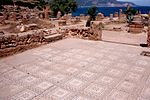
|| align="center" | Tipaza,![]() الجزائر
الجزائر
36°35′31″N 2°26′58″E / 36.591944°N 2.449444°E || Cultural:
(iii), (iv) || align="center" | 52 (130) || align="center" | 1982 || First a Carthaginian trading centre, Tipasa was converted into a military base by the Romans. Heavy Christian influences can be seen from the 3rd and 4th centuries, though Tipasa went into steady decline in the Byzantine period.[184] Tipasa was classified as endangered in 2002 due to natural and human-caused deterioration of the archaeological remains,[185] but was removed from the list in 2006 due to improved protection of the site.[186]
|- ! scope="row" | Tiya
|
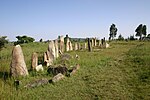
|| align="center" | Southern Nations, Nationalities, and People's Region,![]() ايٿوپيا
ايٿوپيا
8°26′06″N 38°36′44″E / 8.434910°N 38.612100°E || Cultural:
(i), (iv) || align="center" | — || align="center" | 1980 || The archaeological site contains 36 monuments, which includes 32 carved stelae covered with symbols hard to decrypt.[187]
|- style="background:#FFE6BD" ! scope="row" | Tomb of Askiaسانچو:†
|
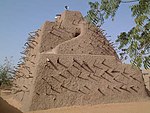
|| align="center" | Gao Region,![]() مالي
مالي
16°17′23″N 0°02′40″E / 16.289800°N 0.044560°E || Cultural:
(ii), (iii), (iv) || align="center" | 4 (9.9) || align="center" | 2004 || Built in 1495, the pyramid was built as a tomb for Emperor Askia Mohamed. It represents the power of an empire that controlled the trans-Saharan gold trade.[188] The site was deemed endangered after the Battle of Gao in June 2012, which followed several weeks of constant threats to the area.[189]
|- style="background:#FFE6BD" ! scope="row" | Tombs of Buganda Kings at Kasubiسانچو:†
|
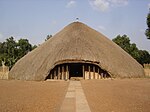
|| align="center" | Kampala District,![]() يوگينڊا
يوگينڊا
0°19′45″N 32°33′12″E / 0.329167°N 32.553333°E || Cultural:
(i), (iii),
(iv), (vi) || align="center" | 27 (67) || align="center" | 2001 || The tombs, built after 1884, are a major example of prime architecture using organic materials, principally wood, thatch, reed, and wattle and daub.[190] The tombs were almost completely destroyed by a fire in March 2010, prompting the World Heritage Committee to reluctantly mark the site as being in danger.[191] The Ugandan government has since called for the reconstruction of the tombs, and UNESCO has agreed to mobilise funds for the project.[192]
|- ! scope="row" | Tsingy de Bemaraha Strict Nature Reserve
|
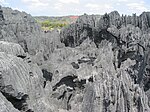
|| align="center" | Melaky,![]() مڊگاسڪر
مڊگاسڪر
18°40′00″S 44°45′00″E / 18.666670°S 44.75°E || Natural:
(vii), (x) || align="center" | 152٬000 (380٬000) || align="center" | 1990 || The canyon of the Manambolo River comprises karstic and limestone landscapes cut into peaks and a forest of limestone needles. It also holds undisturbed forests, lakes, and mangrove swamps, which are the habitat for lemurs and birds.[193]
|}
حوالا
[سنواريو]- ↑ "Number of World Heritage Properties by region". UNESCO. حاصل ڪيل 10 September 2011.
- ↑ حوالي جي چڪ: Invalid
<ref>tag; no text was provided for refs namedlist - ↑ "Aapravasi Ghat". UNESCO. حاصل ڪيل 28 May 2010.
- ↑ "Abu Mena". UNESCO. حاصل ڪيل 28 May 2010.
- ↑ "Abu Mena – Threats to the Site (2001)". UNESCO. حاصل ڪيل 27 August 2010.
- ↑ "Air and Ténéré Natural Reserves". UNESCO. حاصل ڪيل 28 May 2010.
- ↑ "Air and Ténéré Natural Reserves – Threats to the Site (1992)". UNESCO. حاصل ڪيل 28 August 2010.
- ↑ "Decision 33COM 7A.10 – Air and Ténéré Natural Reserves (Niger) (N 573)". UNESCO. حاصل ڪيل 28 August 2010.
- ↑ "Aksum". UNESCO. حاصل ڪيل 28 May 2010.
- ↑ "Al Qal'a of Beni Hammad". UNESCO. حاصل ڪيل 28 May 2010.
- ↑ "Aldabra Atoll". UNESCO. حاصل ڪيل 28 May 2010.
- ↑ "Amphitheatre of El Jem". UNESCO. حاصل ڪيل 28 May 2010.
- ↑ "Ancient Ferrous Metallurgy Sites of Burkina Faso". UNESCO. حاصل ڪيل 9 July 2019.
- ↑ "Ancient Ksour of Ouadane, Chinguetti, Tichitt and Oualata". UNESCO. حاصل ڪيل 28 May 2010.
- ↑ "Ancient Thebes with its Necropolis". UNESCO. حاصل ڪيل 28 May 2010.
- ↑ "Archaeological Site of Carthage". UNESCO. حاصل ڪيل 28 May 2010.
- ↑ "Archaeological Site of Cyrene". UNESCO. حاصل ڪيل 28 May 2010.
- ↑ "Libya's five World Heritage sites put on List of World Heritage in Danger". UNESCO. حاصل ڪيل 7 November 2021.
- ↑ "Archaeological Site of Leptis Magna". UNESCO. حاصل ڪيل 28 May 2010.
- ↑ "Libya's five World Heritage sites put on List of World Heritage in Danger". UNESCO. حاصل ڪيل 7 November 2021.
- ↑ "Archaeological Site of Sabratha". UNESCO. حاصل ڪيل 28 May 2010.
- ↑ "Libya's five World Heritage sites put on List of World Heritage in Danger". UNESCO. حاصل ڪيل 7 November 2021.
- ↑ "Archaeological Site of Volubilis". UNESCO. حاصل ڪيل 28 May 2010.
- ↑ "Archaeological Sites of the Island of Meroe". UNESCO. حاصل ڪيل 17 August 2011.
- ↑ "Asante Traditional Buildings". UNESCO. حاصل ڪيل 28 May 2010.
- ↑ "Asmara: a Modernist African City". UNESCO. حاصل ڪيل 6 November 2021.
- ↑ "Barberton Makhonjwa Mountains". UNESCO. حاصل ڪيل 1 August 2018.
- ↑ "Banc d'Arguin National Park". UNESCO. حاصل ڪيل 28 May 2010.
- ↑ "Bassari Country: Bassari, Fula and Bedik Cultural Landscapes". UNESCO. حاصل ڪيل 4 August 2013.
- ↑ "Bwindi Impenetrable National Park". UNESCO. حاصل ڪيل 28 May 2010.
- ↑ "Cape Floral Region Protected Areas". UNESCO. حاصل ڪيل 28 May 2010.
- ↑ "Chongoni Rock-Art Area". UNESCO. حاصل ڪيل 28 May 2010.
- ↑ "Cidade Velha, Historic Centre of Ribeira Grande". UNESCO. حاصل ڪيل 28 May 2010.
- ↑ "Cliff of Bandiagara (Land of the Dogons)". UNESCO. حاصل ڪيل 28 May 2010.
- ↑ "Comoé National Park". UNESCO. حاصل ڪيل 28 May 2010.
- ↑ "Decision – 27 COM 8B.1 – New Incriptions on the List of World Heritage in Danger". UNESCO. حاصل ڪيل 30 August 2010.
- ↑ "The World Heritage site of Comoé National Park in Côte d'Ivoire no longer in danger". UNESCO. حاصل ڪيل 31 October 2021.
- ↑ "Dja Faunal Reserve". UNESCO. حاصل ڪيل 28 May 2010.
- ↑ "Djémila". UNESCO. حاصل ڪيل 28 May 2010.
- ↑ "Djoudj National Bird Sanctuary". UNESCO. حاصل ڪيل 28 May 2010.
- ↑ "Decision – CONF 004 X.26-27 – Inscriptions on the List of World Heritage in Danger". UNESCO. حاصل ڪيل 9 November 2021.
- ↑ "Decision – CONF 001 XIV.C – Removal from the List of World Heritage in Danger: Djoudj National Park (Senegal)". UNESCO. حاصل ڪيل 9 November 2021.
- ↑ "Decision – CONF 204 VIII.22 – Djoudj National Bird Sanctuary (Senegal)". UNESCO. حاصل ڪيل 9 November 2021.
- ↑ "Decision – 30 COM 7A.11 – Djoudj National Bird Sanctuary (Senegal) (N 25)". UNESCO. حاصل ڪيل 9 November 2021.
- ↑ "Dougga / Thugga". UNESCO. حاصل ڪيل 28 May 2010.
- ↑ "Ecosystem and Relict Cultural Landscape of Lopé-Okanda". UNESCO. حاصل ڪيل 28 May 2010.
- ↑ "Ennedi Massif: Natural and Cultural Landscape". UNESCO. حاصل ڪيل 6 August 2016.
- ↑ "Fasil Ghebbi, Gondar Region". UNESCO. حاصل ڪيل 28 May 2010.
- ↑ "Fort Jesus, Mombasa". UNESCO. حاصل ڪيل 11 July 2011.
- ↑ "Forts and Castles, Volta, Greater Accra, Central and Western Regions". UNESCO. حاصل ڪيل 28 May 2010.
- ↑ "Fossil Hominid Sites of South Africa". UNESCO. حاصل ڪيل 10 November 2021.
- ↑ "French Austral Lands and Seas". UNESCO. حاصل ڪيل 9 July 2019.
- ↑ "Garajonay National Park". UNESCO. حاصل ڪيل 28 May 2010.
- ↑ "Garamba National Park". UNESCO. حاصل ڪيل 28 May 2010.
- ↑ "Decision – 08COM X.26–27 – Inscriptions on the List of World Heritage in Danger". UNESCO. حاصل ڪيل 10 September 2011.
- ↑ "Decision – 16COM X.E – Removed from the World Heritage List in Danger: Garamba National Park (Zaire)". UNESCO. حاصل ڪيل 10 September 2011.
- ↑ Convention Concerning the Protection of the World Cultural and Natural Heritage, Eighth Ordinary Session (PDF) (Report). Buenos Aires: UNESCO. حاصل ڪيل 10 September 2011.
- ↑ "VII.37 Garamba National Park (Zaire)". Convention Concerning the Protection of the World Cultural and Natural Heritage, Twentieth Session (Report). Merida, Mexico: UNESCO. حاصل ڪيل 10 September 2011.
- ↑ "Gebel Barkal and the Sites of the Napatan Region". UNESCO. حاصل ڪيل 28 May 2010.
- ↑ "Gough and Inaccessible Islands". UNESCO. حاصل ڪيل 28 May 2010.
- ↑ "Great Zimbabwe National Monument". UNESCO. حاصل ڪيل 28 May 2010.
- ↑ "Harar Jugol, the Fortified Historic Town". UNESCO. حاصل ڪيل 28 May 2010.
- ↑ "Historic Cairo". UNESCO. حاصل ڪيل 28 May 2010.
- ↑ "Historic Centre of Agadez". UNESCO. حاصل ڪيل 4 August 2013.
- ↑ "Historic City of Meknes". UNESCO. حاصل ڪيل 28 May 2010.
- ↑ "Historic Town of Grand-Bassam". UNESCO. حاصل ڪيل 19 September 2012.
- ↑ "Ichkeul National Park". UNESCO. حاصل ڪيل 28 May 2010.
- ↑ "Decision – CONF 201 VII.D.36 – SOC: Ichkeul National Park (Tunisia)". UNESCO. حاصل ڪيل 11 November 2021.
- ↑ "Cologne Cathedral (Germany), Djoudj Bird Sanctuary (Senegal), Ichkeul National Park (Tunisia), and Hampi (India) removed from List of World Heritage in Danger". UNESCO. حاصل ڪيل 11 November 2021.
- ↑ "iSimangaliso Wetland Park". UNESCO. حاصل ڪيل 28 May 2010.
- ↑ "Island of Gorée". UNESCO. حاصل ڪيل 28 May 2010.
- ↑ "Island of Mozambique". UNESCO. حاصل ڪيل 28 May 2010.
- ↑ "Island of Saint-Louis". UNESCO. حاصل ڪيل 28 May 2010.
- ↑ "Ivindo National Park". UNESCO. حاصل ڪيل 7 November 2021.
- ↑ "Kahuzi-Biega National Park". UNESCO. حاصل ڪيل 28 May 2010.
- ↑ "Kahuzi-Biega National Park – Threats to the Site (1997)". UNESCO. حاصل ڪيل 10 September 2011.
- ↑ "Kairouan". UNESCO. حاصل ڪيل 28 May 2010.
- ↑ "Kasbah of Algiers". UNESCO. حاصل ڪيل 28 May 2010.
- ↑ "Kenya Lake System in the Great Rift Valley". UNESCO. حاصل ڪيل 28 June 2011.
- ↑ "Khami Ruins National Monument". UNESCO. حاصل ڪيل 28 May 2010.
- ↑ "ǂKhomani Cultural Landscape". UNESCO. حاصل ڪيل 16 July 2017.
- ↑ "Kilimanjaro National Park". UNESCO. حاصل ڪيل 28 May 2010.
- ↑ "Kondoa Rock-Art Sites". UNESCO. حاصل ڪيل 28 May 2010.
- ↑ "Konso Cultural Landscape". UNESCO. حاصل ڪيل 17 August 2011.
- ↑ "Koutammakou, the Land of the Batammariba". UNESCO World Heritage Centre. UNESCO. حاصل ڪيل 18 July 2024.
- ↑ "Ksar of Ait-Ben-Haddou". UNESCO. حاصل ڪيل 28 May 2010.
- ↑ "Kunta Kinteh Island and Related Sites". UNESCO. حاصل ڪيل 6 November 2015.
- ↑ "Lake Malawi National Park". UNESCO. حاصل ڪيل 28 May 2010.
- ↑ "Lakes of Ounianga". UNESCO. حاصل ڪيل 11 July 2013.
- ↑ "Lake Turkana National Parks". UNESCO. حاصل ڪيل 28 May 2010.
- ↑ "Lake Turkana National Parks (Kenya) inscribed on List of World Heritage in Danger". UNESCO. حاصل ڪيل 28 June 2018.
- ↑ "Lamu Old Town". UNESCO. حاصل ڪيل 28 May 2010.
- ↑ "Laurisilva of Madeira". UNESCO. حاصل ڪيل 28 May 2010.
- ↑ "Le Morne Cultural Landscape". UNESCO. حاصل ڪيل 28 May 2010.
- ↑ "Lower Valley of the Awash". UNESCO. حاصل ڪيل 28 May 2010.
- ↑ "Lower Valley of the Omo". UNESCO. حاصل ڪيل 28 May 2010.
- ↑ "M'Zab Valley". UNESCO. حاصل ڪيل 28 May 2010.
- ↑ "Maloti-Drakensberg Park". UNESCO. حاصل ڪيل 4 August 2013.
- ↑ "Mana Pools National Park, Sapi and Chewore Safari Areas". UNESCO. حاصل ڪيل 28 May 2010.
- ↑ "Manovo-Gounda St Floris National Park". UNESCO. حاصل ڪيل 28 May 2010.
- ↑ حوالي جي چڪ: Invalid
<ref>tag; no text was provided for refs namedmanovodang - ↑ "Mapungubwe Cultural Landscape". UNESCO. حاصل ڪيل 28 May 2010.
- ↑ "Matobo Hills". UNESCO. حاصل ڪيل 28 May 2010.
- ↑ "Mbanza Kongo, Vestiges of the Capital of the former Kingdom of Kongo". UNESCO World Heritage Centre. UNESCO. حاصل ڪيل 18 July 2024.
- ↑ "Medina of Essaouira (formerly Mogador)". UNESCO. حاصل ڪيل 28 May 2010.
- ↑ "Medina of Fez". UNESCO. حاصل ڪيل 28 May 2010.
- ↑ "Medina of Marrakesh". UNESCO. حاصل ڪيل 28 May 2010.
- ↑ "Medina of Sousse". UNESCO. حاصل ڪيل 28 May 2010.
- ↑ "Medina of Tétouan (formerly known as Titawin)". UNESCO. حاصل ڪيل 28 May 2010.
- ↑ "Medina of Tunis". UNESCO. حاصل ڪيل 28 May 2010.
- ↑ "Memphis and its Necropolis – the Pyramid Fields from Giza to Dahshur". UNESCO. حاصل ڪيل 28 May 2010.
- ↑ "Mosi-oa-Tunya / Victoria Falls". UNESCO. حاصل ڪيل 28 May 2010.
- ↑ "Mount Kenya National Park/Natural Forest". UNESCO. حاصل ڪيل 28 May 2010.
- ↑ "Mount Nimba Strict Nature Reserve". UNESCO. حاصل ڪيل 28 May 2010.
- ↑ "Mount Nimba Strict Nature Reserve – Threats to the Site (1992)". UNESCO. حاصل ڪيل 11 September 2011.
- ↑ "Decision – 43 COM 7A.6 – Mount Nimba Strict Nature Reserve (Côte d'Ivoire/Guinea) (N 155bis)". UNESCO. حاصل ڪيل 4 November 2021.
- ↑ "Namib Sand Sea". UNESCO. حاصل ڪيل 4 August 2013.
- ↑ "Ngorongoro Conservation Area". UNESCO. حاصل ڪيل 28 May 2010.
- ↑ "Decision – CONF 004 X.26-27 – Inscriptions on the List of World Heritage in Danger". UNESCO. حاصل ڪيل 11 November 2021.
- ↑ "Decision – CONF 004 XV.D – Removal from the List of World Heritage in Danger: Ngoronaoro Conservation Area (Tanzania)". UNESCO. حاصل ڪيل 11 November 2021.
- ↑ "Niokolo-Koba National Park". UNESCO. حاصل ڪيل 28 May 2010.
- ↑ "Decision – 31COM 7B.1 – State of conservation of World Heritage Properties – Niokolo-Koba National Park". UNESCO. حاصل ڪيل 11 September 2011.
- ↑ "Nubian Monuments from Abu Simbel to Philae". UNESCO. حاصل ڪيل 28 May 2010.
- ↑ "Okapi Wildlife Reserve". UNESCO. حاصل ڪيل 28 May 2010.
- ↑ "Okapi Wildlife Reserve – Threats to the Site (1997)". UNESCO. حاصل ڪيل 11 September 2011.
- ↑ "Okavango Delta". UNESCO World Heritage Centre. UNESCO. حاصل ڪيل 18 July 2024.
- ↑ "Old Towns of Djenné". UNESCO. حاصل ڪيل 28 May 2010.
- ↑ "Mali's Old Towns of Djenné on List of World Heritage in Danger". UNESCO. حاصل ڪيل 9 November 2021.
- ↑ "Old Town of Ghadamès". UNESCO. حاصل ڪيل 28 May 2010.
- ↑ "Libya's five World Heritage sites put on List of World Heritage in Danger". UNESCO. حاصل ڪيل 7 November 2021.
- ↑ "Osun-Osogbo Sacred Grove". UNESCO. حاصل ڪيل 28 May 2010.
- ↑ "Pitons, cirques and remparts of Reunion Island". UNESCO. حاصل ڪيل 10 July 2011.
- ↑ "Portuguese City of Mazagan (El Jadida)". UNESCO. حاصل ڪيل 28 May 2010.
- ↑ "Punic Town of Kerkuane and its Necropolis". UNESCO. حاصل ڪيل 28 May 2010.
- ↑ "Rabat, Modern Capital and Historic City: a Shared Heritage". UNESCO. حاصل ڪيل 30 June 2012.
- ↑ "Rainforests of the Atsinanana". UNESCO. حاصل ڪيل 9 November 2021.
- ↑ "Decision – 34COM 7B.2 – Rainforests of Atsinanana (Madagascar) (N 1257)". UNESCO. حاصل ڪيل 11 September 2011.
- ↑ "Richtersveld Cultural and Botanical Landscape". UNESCO. حاصل ڪيل 28 May 2010.
- ↑ "Risco Caido and the Sacred Mountains of Gran Canaria Cultural Landscape". UNESCO. حاصل ڪيل 9 July 2019.
- ↑ "Robben Island". UNESCO. حاصل ڪيل 28 May 2010.
- ↑ "Rock-Art Sites of Tadrart Acacus". UNESCO. حاصل ڪيل 28 May 2010.
- ↑ "Libya's five World Heritage sites put on List of World Heritage in Danger". UNESCO. حاصل ڪيل 7 November 2021.
- ↑ "Rock-Hewn Churches, Lalibela". UNESCO. حاصل ڪيل 28 May 2010.
- ↑ "Royal Hill of Ambohimanga". UNESCO. حاصل ڪيل 28 May 2010.
- ↑ "Royal Palaces of Abomey". UNESCO. حاصل ڪيل 28 May 2010.
- ↑ "Inscription on the List of World Heritage in Danger: Royal Palaces of Abomey (Benin)". UNESCO. حاصل ڪيل 4 November 2021.
- ↑ "Update of the list of the World Heritage in danger - removal - Royal Palaces of Abomey, Río Plátano Biosphere Reserve, Kathmandu Valley, Everglades National Park". UNESCO. حاصل ڪيل 4 November 2021.
- ↑ "Ruins of Kilwa Kisiwani and Ruins of Songo Mnara". UNESCO. حاصل ڪيل 28 May 2010.
- ↑ "Decision – 28COM 15B.41 – Ruins of Kilwa Kisiwani and Ruins of Songo Mnara (United Republic of Tanzania)". UNESCO. حاصل ڪيل 11 September 2011.
- ↑ "Tanzania's Ruins of Kilwa Kisiwani and Ruins of Songo Mnara removed from UNESCO List of World Heritage in Danger". UNESCO. حاصل ڪيل 11 November 2021.
- ↑ "Ruins of Loropéni". UNESCO. حاصل ڪيل 11 November 2015.
- ↑ "Rwenzori Mountains National Park". UNESCO. حاصل ڪيل 28 May 2010.
- ↑ "World Heritage Committee Adds Four Sites to the List of World Heritage in Danger". UNESCO. حاصل ڪيل 12 November 2021.
- ↑ "Angkor Among the three Properties Removed from Unesco's List of World Heritage in Danger". UNESCO. حاصل ڪيل 12 November 2021.
- ↑ "Sacred Mijikenda Kaya Forests". UNESCO. حاصل ڪيل 28 May 2010.
- ↑ "Saint Catherine Area". UNESCO. حاصل ڪيل 28 May 2010.
- ↑ "Salonga National Park". UNESCO. حاصل ڪيل 28 May 2010.
- ↑ "Decision – 23COM X.B.21 – SOC: Salonga National Park (Democratic Republic of the Congo (DRC))". UNESCO. https://whc.unesco.org/en/decisions/2666.
- ↑ "Salonga National Park (Democratic Republic of the Congo) removed from the List of World Heritage in Danger". UNESCO. http://whc.unesco.org/en/news/2313/.
- ↑ "Saloum Delta". UNESCO. حاصل ڪيل 17 August 2011.
- ↑ "Sanganeb Marine National Park and Dungonab Bay – Mukkawar Island Marine National Park". UNESCO. حاصل ڪيل 6 August 2016.
- ↑ "San Cristóbal de la Laguna". UNESCO. حاصل ڪيل 28 May 2010.
- ↑ "Sangha Trinational". UNESCO. حاصل ڪيل 11 November 2015.
- ↑ "Selous Game Reserve". UNESCO. حاصل ڪيل 28 May 2010.
- ↑ "Poaching puts Tanzania's Selous Game Reserve on List of World Heritage in Danger". UNESCO. حاصل ڪيل 11 November 2021.
- ↑ "Serengeti National Park". UNESCO. حاصل ڪيل 28 May 2010.
- ↑ "Simien National Park". UNESCO. حاصل ڪيل 1 August 2010.
- ↑ "Decision – CONF 201 VII.D.32 – SOC: Simien National Park (Ethiopia)". UNESCO. حاصل ڪيل 7 November 2021.
- ↑ "Ethiopian World Heritage site, Simien National Park no longer in danger". UNESCO. حاصل ڪيل 7 November 2021.
- ↑ "Stone Circles of Senegambia". UNESCO. حاصل ڪيل 28 May 2010.
- ↑ "Stone Town of Zanzibar". UNESCO. حاصل ڪيل 28 May 2010.
- ↑ "Sudanese style mosques in northern Côte d'Ivoire". UNESCO. حاصل ڪيل 31 October 2021.
- ↑ "Sukur Cultural Landscape". UNESCO. حاصل ڪيل 28 May 2010.
- ↑ "Taï National Park". UNESCO. حاصل ڪيل 28 May 2010.
- ↑ "Tassili n'Ajjer". UNESCO. حاصل ڪيل 28 May 2010.
- ↑ "Teide National Park". UNESCO. حاصل ڪيل 28 May 2010.
- ↑ "Thimlich Ohinga Archaeological Site". UNESCO. حاصل ڪيل 1 August 2018.
- ↑ "Timbuktu". UNESCO. حاصل ڪيل 28 May 2010.
- ↑ "Decision – CONF 004 VII.C – Inscription on the List of World Heritage in Danger: Timbuktu (Mali)". UNESCO. حاصل ڪيل 9 November 2021.
- ↑ "Decision – 29 COM 7A.14 – Timbuktu (Mali)". UNESCO. حاصل ڪيل 9 November 2021.
- ↑ "Heritage sites in northern Mali placed on List of World Heritage in Danger". UNESCO. حاصل ڪيل 9 November 2021.
- ↑ "Ansar Dine fighters destroy Timbuktu shrines". Al Jazeera. 30 June 2012. http://www.aljazeera.com/news/africa/2012/06/2012630101748795606.html.
- ↑ "Timgad". UNESCO. حاصل ڪيل 28 May 2010.
- ↑ "Tipasa". UNESCO. حاصل ڪيل 11 January 2011.
- ↑ "Tipasa (Algeria) Added to List of World Heritage in Danger". UNESCO. حاصل ڪيل 4 November 2021.
- ↑ "Updates of the World Heritage List in Danger (Removed Properties)". UNESCO. حاصل ڪيل 4 November 2021.
- ↑ "Tiya". UNESCO. حاصل ڪيل 28 May 2010.
- ↑ "Tomb of Askia". UNESCO. حاصل ڪيل 28 May 2010.
- ↑ "Heritage sites in northern Mali placed on List of World Heritage in Danger". UNESCO. 28 June 2012. https://whc.unesco.org/en/news/893.
- ↑ "Tombs of Buganda Kings at Kasubi". UNESCO. حاصل ڪيل 28 May 2010.
- ↑ "Decision – 34COM 7B.53 – Tombs of Buganda Kings at Kasubi (Uganda) (C 1022)". UNESCO. حاصل ڪيل 11 September 2011.
- ↑ "Uganda tombs to be reconstructed". Afrol News. 13 April 2010. http://www.afrol.com/articles/35917.
- ↑ "Tsingy de Bemaraha Strict Nature Reserve". UNESCO. حاصل ڪيل 28 May 2010.
حوالي جي چڪ: "lower-alpha" نالي جي حوالن جي لاءِ ٽيگ <ref> آهن، پر لاڳاپيل ٽيگ <references group="lower-alpha"/> نہ مليو
